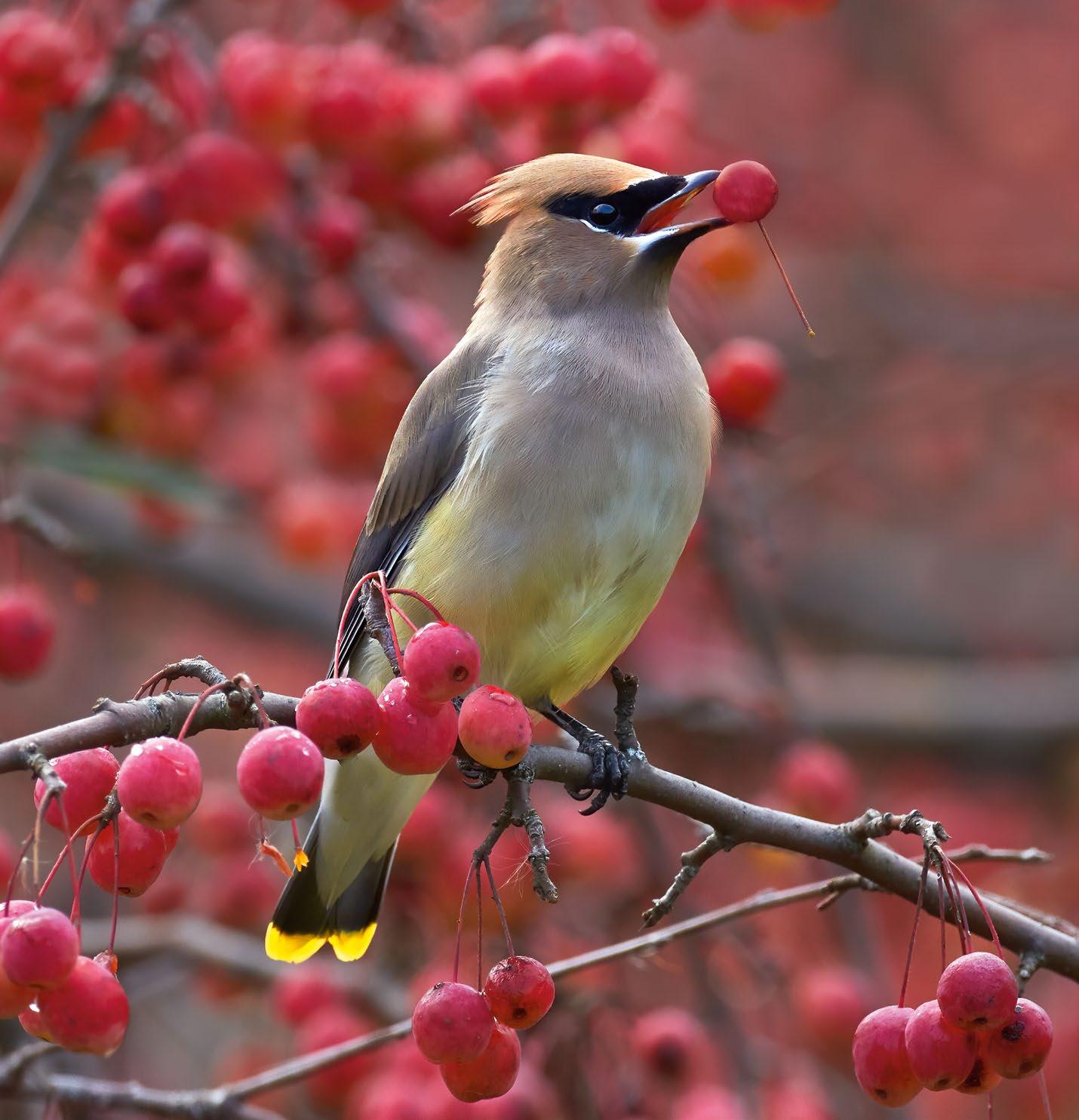
WINTER BIRD COUNTS
OUR ANNUAL TRIBUTE TO LOCAL HEROES
ZOE BOYD : SKATING IN THE BIG LEAGUE LOCAL BOOKS TO SHARE





























OUR ANNUAL TRIBUTE TO LOCAL HEROES
ZOE BOYD : SKATING IN THE BIG LEAGUE LOCAL BOOKS TO SHARE










































































35 LOCAL HEROES
A salute to eight people whose passionate work has changed our community for the better BY GAIL GRANT, TONY REYNOLDS, JEFF ROLLINGS AND NICOLA ROSS
46 THE YEAR IN BOOKS
Delve into our annual review of new books by local authors – from mystery to fantasy and self-help to poetry, there’s something for everyone on your gift list BY
PETER YAN
54 TWO IN THE BUSH
The Christmas Bird Count provides a snapshot of overwintering local birds and an opportunity for birders to enjoy some holiday camaraderie BY
DON SCALLEN
60 MAKING IT TO THE BIG LEAGUE
Caledon’s Zoe Boyd grew up on the ice, but even as an exceptional player her career options in women’s hockey were limited – then she got drafted by the brand new Professional Women’s Hockey League BY
ANTHONY JENKINS
65 NIGHT MOVES
How hitting the winter trails after dark transforms a common daylight pastime into an awe-inspiring outing BY
ANNA LEE BOSCHETTO







25 ARTIST IN RESIDENCE Pat Hertzberg
27 FIELD NOTES
Greet winter with holiday concerts, an art show that looks at love and the creative process — and more BY EMILY DICKSON
31 FENCE POSTS A rough neighbourhood BY DAN NEEDLES
68 FOOD AND DRINK Chic prix fixe, holiday chocolate, foodie gifts or turkey to go BY EMILY DICKSON
ROSS 21 LETTERS Our readers write
72 MEET THE MAKER Nicola Kidd’s wooden whimsies BY EMILY DICKSON

82 HEADWATERS NEST
Wrapping up memories BY BETHANY LEE
84 OVER THE NEXT HILL Writing your own story BY GAIL GRANT
86 AT HOME IN THE HILLS A Dutch farmhouse dream BY JANICE QUIRT
98 FIND AN ADVERTISER
102 WHAT’S ON A calendar of winter happenings
114 BACK STORY Now, that’s a snow fort! BY DYANNE RIVERS



Skin remodeling from the inside out
Secret RF improves:
• Fine lines and wrinkles
• Skin tone and texture
• Photo damage
• Scars
EDITOR
ASSOCIATE EDITOR
Dyanne Rivers
ART DIRECTOR
Kim van Oosterom
Wallflower Design
PHOTOGRAPHERS
Darren Calabrese
Erin Fitzgibbon
Rosemary Hasner
Elaine Li
Robert McCaw
Christinne Muschi
Pete Paterson
Miguel Vadillo
ILLUSTRATORS
Shelagh Armstrong
Ruth Ann Pearce

Mention this ad and
Find out how you can achieve younger looking skin — schedule a treatment with us today. Consultations always FREE


Anna Lee Boschetto
Emily Dickson
Gail Grant
Anthony Jenkins
Bethany Lee
Alison McGill
Dan Needles
Janice Quirt
Tony Reynolds
Jeff Rollings
Nicola Ross
Don Scallen
Peter Yan
Jim Stewart WRITERS

Roberta Fracassi Erin Woodley
Cindy Caines Dillman
ADVERTISING PRODUCTION
Marion Hodgson
Type & Images
EVENTS & COPY EDITOR
Janet Kerr
DIGITAL EDITORS
Emily Dickson
Janice Quirt
FOUNDING PUBLISHER Signe Ball
In The Hills is published quarterly by MonoLog Communications Inc. It is distributed through controlled circulation to households in the towns of Caledon, Erin, Orangeville, Shelburne, Creemore, and Dufferin County.
Annual subscriptions outside the distribution area are $32.95 for 1 year and $58.95 for 2 years (including HST).
© 2024 MonoLog Communications Inc. All rights reserved. No reproduction by any means or in any form may be made without prior written consent by the publisher.
For information regarding editorial content or letters to the editor: tralee@inthehills.ca.
Find us online at www.inthehills.ca Like us facebook.com/InTheHills Follow us twitter.com/inthehillsmag and instagram.com/inthehillsmag
For advertising, contact one of our regional sales managers:
Roberta Fracassi 519-943-6822, roberta@inthehills.ca (Orangeville, Shelburne, Creemore and areas N of Hwy 9)
Erin Woodley 519-216-3795, erin@inthehills.ca (Caledon, Bolton, Erin and areas S of Hwy 9)
The ad booking deadline for the spring (March) issue is Friday, February 7, 2025.
Canada Post Agreement Number 40015856
We acknowledge the support of the Government of Canada.









How, exactly, can you measure the strength of a community like ours here in Headwaters? I have no magic formula, but in this issue, some numbers tell a story.
Erin farmers Della Campbell and Gavin Dandy of Everdale grow an astounding 20,000 pounds of fresh produce annually for local food banks. About 100 women visit the emergency women’s shelter in Orangeville every year for support in their most vulnerable moments – thanks to a team led until recently by Norah Kennedy, who has just retired after 17 years as executive director. Outgoing (in both senses of the word) Theatre Orangeville artistic director David Nairn has overseen a whopping 90 plays and musicals during his 25-year tenure. And since 2003, Caledon cancer walk stalwart Barbara Karasiuk and her teams have raised $700,000 for research.
We also meet three local athletes in these pages who are racking up historic stats, all while pushing the boundaries of their chosen sports. Hockey players Zoe Boyd and her friend Kristin Della Rovere made history as day-oners in the PWHL, the first-ever women’s professional hockey league in North America. And who can forget Olympic bronze medallist Alysha Newman as she polevaulted over a 4.85-metre bar, the highest she’d ever achieved, in Paris this summer? She also set a Canadian record and stepped into a sisterhood of fewer than 10 women worldwide who have cleared that height. (Zoe, Kristin and Alysha all have ties to Caledon East. Really, there must be something in the water.)
Some folks in this issue take on so many volunteer hours and community service gigs, it’s easy to lose count. Along with her fulltime day job, Alethia O’Hara-Stephenson is also the founder of the Dufferin County Canadian Black Association, a school trustee, a community TV host and more. And retiree Linda Banks, instead of kicking back to relax in her senior years, won’t stop assigning herself new volunteer tasks and other acts of service. It’s possible these women have unlocked more than 24 hours in their day.
While we’re attempting to keep count, a tip of the toque to the professional and amateur birders who head out each winter for the Christmas Bird Count – a snapshot of how many wintering birds are in our midst. In The Hills writer and veteran birder Don Scallen chronicles last year’s count, in which his fellow enthusiasts observed 1,217 Canada geese, 732 black-capped chickadees and 374 cedar waxwings – this issue’s cover star – among others.
I imagine it’s no mean feat to keep your binoculars trained on those waxwings as they swoop and dart about. Likewise, tallying the individual accomplishments of the doers highlighted in this issue – eight of them on our annual Local Heroes list – feels just as demanding, but no less rewarding.
Though you can’t really add up all these figures, they tell us a lot about our neighbours and how their outreach and hard work radiates into the community. That’s strength in numbers, don’t you think?
Happy holidays from all of us at In The Hills!




Peter Yan
Peter makes his first appearance in In The Hills tackling our annual “Year in Books” feature. A selfdescribed CBC (Canadian-born Chinese, although he is also a fan of our national broadcaster), Peter is a retired English teacher whose previous reviews have appeared in Books in Canada. His love of literature led to his obsession with renowned Canadian literary critic Northrop Frye. Peter has the distinction of publishing the final interview with Frye, who died at 78 in 1991. “My friends claim my inane questions may have contributed to his death,” he jokes.
Peter says he feels honoured to review fellow Headwaters writers and hopes their creativity will rub off on his own writing. His favourite pastimes include pickleball, doubles tennis, and baking sourdough. He lives in Mulmur with his wife and doubles partner, Leah, and has two sons, Dylan and Coltrane.

Woodley
When a new issue of In The Hills comes out, our regional sales managers each load about 1,500 copies straight into their cars, ready to tour our towns and countryside hand-delivering magazines to as many of their valued clients as possible.
Erin Woodley, the magazine’s regional sales manager for Caledon, Bolton, Erin and other areas south of Highway 9, considers getting out and seeing her clients the highlight of her work. It can take three or four days to make the rounds. “They’re happy to see me and receive the magazine, and I’m happy to connect with them face to face. It’s what makes this job special.”
Erin, who lives in Orangeville, has been with the magazine for more than 11 years. When she isn’t working she can often be found boating with her husband, John, exploring the beauty of Georgian Bay.


Roberta Fracassi
As a regional sales manager for nearly 17 years, Roberta is a well-known, friendly face to her clients in Orangeville, Shelburne, Rosemont and other locations north of Highway 9. Roberta has seen the magazine evolve over the years, but says one thing remains constant: marketing with In The Hills gets results.
“I have some clients who have been with me since the very beginning because they see the quality of the writing and the overall quality of the publication, and they know it works for them,” says Roberta, who calls Orangeville home. “When you walk into a business, In The Hills is in the reception area or on the coffee table. And at home it’s a gift in the mailbox; readers are excited to open it and see what’s inside. It’s not a magazine people throw out – and that makes my job a pleasure.”









NEW SYSTEM PURCHASE: Save $200 on any new Kinetico water system. Promo Code: WINTER200
Promo Code: WINTER10
HURRY! OFFERS VALID ONLY THROUGH THE IN THE HILLS WINTER ISSUE. CALL TODAY AND MENTION YOUR PROMO CODE TO REDEEM.
EXPERIENCE BETTER WATER. EXPERIENCE KINETICO.








Re At Home in the Hills: “Leaving Their Mark” [autumn ’24]: I have often felt that First Avenue/ Zina Street was such a unique thoroughfare, it deserved a place of its own in Orangeville’s history. My former house is on the corner of First Avenue and Second Street, part of 200 acres of land north of Purple Hill once owned by Seneca Ketchum, one of the town’s founders.

Every house along the two blocks from Third Street to First Street is different. The oldest was the house next to mine, since demolished, reportedly built in the 1850s as an Orange Lodge. Supposedly, there was once a log cabin on my property, but it was long gone, replaced by a house and carriage paint shop in the 1880s. Around the turn of the 20th century, it was raised and a rubble-and-mortar foundation was built under it, whereupon it became a residence. A decade later, a second floor was installed, making it oneand-a-half storeys (apparently taxed less than a full two storeys). This could have been when it was bricked; the original exterior was shiplap timber and there is a 6-inch airspace between the inner and outer walls, in lieu of insulation.
This also explains how soundproof the house is. There’s a good 18-inch to 2-foot gap between the first and second floors, as the original roof rafters are still there. Our teenagers could have their music blasting upstairs and we could barely hear it downstairs. An addition in the 1920s made the house L-shaped. We lived there for 17 years, from the mid-’80s to the early 2000s with many happy memories, but we were far from its longest-standing occupants.
They would have been the Marshalls, whose patriarch, Clifford, then in his 90s, strolled past when we lived there, but would refuse all invitations to come in and see what we’d done with the place. I guess he wanted to remember it as it was when he raised his kids there, at least one of which was born in the house. I feel the same way now myself. The Marshalls lived there for 34 years. One of his sons owned Marshall’s Men’s Wear on Broadway, remembered by old-time residents. In the house, I found a plethora of what would now be called “vintage” items, from comic books dating in the 1950s (under the front porch) to newspapers from the 1920s and a manual for a coal-fired furnace (chinking gaps in the mortared basement) to a cow’s skull buried in the garden with a neat little hole right between the eyes! We redid the kitchen and dining room and, I’m happy to say,
the current owners did a major renovation. The old homestead looks great. Preserving the past while looking toward the future. — Garth Steibel, Mono
We want to share with you how the Headwaters Farm Fresh Guide [summer ’24] was recently used to highlight all the amazing fresh local foods that are available in our community to students at Primrose Elementary School.
At Primrose ES, a group of parent volunteers runs a monthly Salad Bar Day, when students can order ahead and build their own salad as a nutritious lunch option. The program aims to celebrate local foods and offers students the opportunity to try different foods to broaden their culinary horizons. We always do our best to support local farms and offer in-season fruits and vegetables when possible. This fall, for our first salad bar of the school year, every single fruit and vegetable in the salad bar cart (aka Big Red) was sourced from farms within 20 kilometres of the school!
Thanks to your Farm Fresh guide, we are able to discover local options and connect with farms to create a unique salad bar every month. We share with students where their food is coming from, and we highlight some of the more unique or unfamiliar food options by designing simple graphics about a particular vegetable and/or farm. For the fall Salad Bar we used the Farm Fresh guide as a centrepiece to a bulletin board we created to show exactly how close to the school everything was grown.
Between the bulletin board and the “mystery item” we were offering, we generated a huge buzz around the school that day. Students came running down (shhh, don’t tell the teachers they ran in the halls) to Big Red, excited about which farms the food came from and with guesses about what the mystery item would be. Students noticed that some veggies came from their friends’ or neighbours’ farms and, in some cases, even from their own farm. In addition, various herbs were harvested from the school gardens, so some students were able to boast they had a hand in tending to those during the growing season.

As for the mystery item, due to a last-minute offer from a local farm with a bumper crop, we brought in enough cucamelons (pictured left) to cause a stir. Giving kids an opportunity to try them in a no-pressure way resulted in their discovering a new flavour and a new appreciation for what local farmers can grow. We use the Farm Fresh guide to educate students about fresh food, where it comes from, and how easy and fun it can be to eat locally. Thank you for publishing an amazing resource! — Adelle BarrKlouman, Amy Ouchterlony and Annalea Kidd on behalf of the Primrose Salad Bar Team
We welcome your comments! For more reader commentary online, or to add your own thoughts on any of the stories appearing in this issue, visit inthehills.ca. You can also send your letters by email to tralee@inthehills.ca. Please include your name, address and contact information. In The Hills reserves the right to edit letters for publication.



















Clockwise from top left • Fragile Hope, fibre with thread-web technique, 35" x 31" • Sybil’s Aura, fibre with thread-web technique, 40" x 30" Enchanted Forest bowl, fibre with thread-web technique in 3-D, 14" x 14" x 5" • Childhood Memories (detail), acrylic, 45" x 35"
Alton fibre and mixed-media artist Pat Hertzberg’s unyielding artistic drive lies in creating mesmerizing and tactile textures. Pat pioneered her distinctive “thread-web” technique of stitching together huge volumes of small fabric patches or strips; some larger works comprise more than 1,000 individual pieces. She cuts each of these pieces from larger swaths, which she has often hand-dyed or painted earlier in the process. “Viewers standing before my work may be admiring it or trying to figure out how it was made. They might be fighting the urge to touch it – or they could be deciding what to have for dinner,” she jests. “All options are fine with me. Besides selfexpression, the real goal of art is to connect and to provide the conduit for unhurried reflection.” Find her at www.pathertzberg.com



BY EMILY DICKSON


When you’re an artist in a relationship with another artist, do the two worlds overlap? How is your art influenced when you share your life, your home and your profession? These are some of the questions Sharona AdamowiczClements, art curator at the Peel Art Gallery Museum and Archives (PAMA), hopes viewers will ask at In Love and In Art, an exhibit showcasing two prolific artistic couples – Caledon’s Jim Reid and Peggy Taylor Reid, as well as Gina Rorai and David Urban.
“Both couples have a really impressive collection of work individually, but in this exhibit, we wanted to create a tension, sort of teasing the viewer, hinting that you’re looking into their private world to understand the psychology behind the art,” explains Sharona. “We want viewers to wonder, Does their work impact each other? Is there competition? Has one artist been able to inform the work of the other without even realizing?”
Jim and Peggy have been making art – separately – at their home in Terra Cotta for over 40 years, and this is the first time they are being exhibited together. Peggy says artists “need space” to create, and it’s just as important to know when one person needs to be left alone as when they need company, though the couple does admit to wanting each other’s feedback. “Artists tend to be less secure,” Peggy laughs. “They’re always searching and wandering and double guessing. I think we reach out to each other for a kick in the butt, to reassure ourselves that we’re on the right path.”
Asked if they think they influence each other’s art, Jim believes it’s in the eye of the beholder: “I think there are underlying currents that connect us, but maybe on the surface our work looks totally different.” Indeed, their artistic genres seem at odds: Peggy is a photo-based artist while Jim wields the tools of the painter. So, do love and art overlap? You can decide for yourself at the exhibit, which runs from November 23 to April 6, 2025.
Grab your shopping list and head to the Dufferin Christmas Market on November 23 at the Orangeville Fairgrounds. It features artisans’ handcrafted products, plus a sip-and-shop event.
The Museum of Dufferin’s epic Holiday Treasures Craft Market marks its 20th anniversary with more than 60 talented makers, creators and vendors, from November 27 to December 8. You can also make your own treasure at the museum’s Wreath-Making Workshop on December 8, using foliage from the Dufferin County Forest to decorate a 10-inch wreath.
The perfect Christmas tree is waiting for you at local tree farms, including Erin Hill Acres in Hillsburgh with pre-cut or cut-your-own Christmas trees and wagon rides – and live music on weekends. Warm up at a bonfire and sip on gourmet hot chocolate at Erin’s Elliott Tree Farm and explore their Maple Syrup Museum. Or enjoy the magic of a horse-drawn carriage ride through Hockley Valley Farm’s snow-covered forests (weekends only).







Don’t give winter the cold shoulder! Resist the urge to hibernate and head outdoors to embrace the season, starting with a Chill Session Run at Mansfield Outdoor Centre on November 30 followed by hot chili and beverages.
Once there’s enough white stuff on the ground – typically from January to March – bring your own skis or rent a pair at Mono Nordic Ski Club’s crosscountry trails or seek out ungroomed paths when you loop around Ken Whillans Conservation Area. Thrill seekers zip down trails like the Boomerang and B.D.’s Choice at Hockley Valley Resort – don’t miss night skiing this year.
Gear up for the quintessential winter experience of ice fishing when you see the iconic ice huts pop up at Island Lake Conservation Area – the annual Ice Fishing Derby runs from February 8 to 17. If skating is more your speed, take advantage of community centre skate sessions, or skate outdoors at the Alton Mill, the Inglewood Community Outdoor Rink, Mono Community Centre, and Natasha Paterson Memorial Park in Shelburne.

Thirteen-year-old Akeylah James of Shelburne co-hosts TVOKids series Trading Skills, where she meets welders, chefs, cabinetmakers and other professionals to learn about the wide world of skilled trades. “I’ve had so many amazing experiences with this show so far and I can’t wait to learn more from all these talented tradespeople,” says Akeylah. Catch the first six episodes on TVOKids’ YouTube channel.
Christmas at Downey’s Farm Market has it all: wagon rides, scavenger hunts, magic shows, farm animals, mini putt played with hockey sticks, and visits with Santa. Buy tickets in advance for this popular event, which runs from November 30 to December 22.
’Tis the season to take the entire family out to see the magic of live theatre. Find out just how true “happily ever after” is during Norm Foster’s A Snow White Christmas, performed by the Blackhorse Village Players in north Caledon from November 20 to December 8.
It’s also time for silly, boisterous pantomime productions. Hillsburgh’s Century Church Theatre is known for its annual hijinks; this year catch Cinderella, complete with her evil stepsisters and Prince Charming, from November 23 to December 8. And Theatre Orangeville’s panto Sleeping Beauty ... A Fairy’s Tale retells the beloved tale with topsy-turvy twists that will have you cheering and booing from your seat. It runs from November 28 to December 21.
The heartwarming holiday hits keep on coming at Brampton On Stage with Brampton Concert Band’s Christmas at The Rose on December 7, and The Rose Orchestra: Yule Sing on December 14, featuring the delightful young voices of the Brampton Children’s Chorus and St. Roch Chorale.
In the new year, follow four friends on a riotous road trip from Toronto to Newfoundland with Theatre Orangeville’s The Beaver Club, on stage from February 6 to 23.
And if you’re flipping to your March calendar, don’t miss TV personality Tracy Moore at a fundraiser for Family Transition Place on March 7 at Hockley Valley Resort. Visit familytransitionplace.ca for info.




BY DAN NEEDLES • ILLUSTRATED BY SHELAGH ARMSTRONG
IT HAS BECOME COMMONLY ACCEPTED that we live in difficult times. Kids can’t afford a house, taxes eat up disposable income, and the homeless camps on the edge of town grow steadily bigger. The price of everything has doubled and tripled, and gangs are showing up in small towns.
But whether life is any harder than it was 50 years ago is debatable. My wife and I grew up within five miles of each other in two rural townships in Southern Ontario, divided by Highway 89. I didn’t bump into her until I was 36 years old, because we both thought the other lived in a very rough neighbourhood.
For my part, I spent five days in SickKids Hospital in Toronto after a baseball game our little tworoom school in Rosemont hosted for the team from Stanton, north of the highway, in the community where my wife lived. I hit a line drive between first and second that went out through the fence and down into the ditch alongside the road. I was making good time around the bases when suddenly the lights went out.
Somebody from the Stanton team had thrown a piece of a brick at me to slow me down and it sure did the trick. I staggered a few steps off into left field, did a faceplant in the grass and got tagged. Mrs. Raeburn, the umpire, had thick Coke-bottle-bottom glasses and couldn’t see the pitcher let alone a little guy lying in the outfield. She declared me “out” and a couple of kids dragged me to the sidelines. I ended up with a concussion and when I got back from the hospital I made a mental note never to venture north of Highway 89 again.
For my wife’s part, she was brought up on a steady
diet of shocking news flashes that admittedly came far too often from south of the highway. These included farm and road accidents, fires, suicides, a couple of robberies, fatalities from falling trees, a cattle embezzlement scheme and the explosion of a church. (The last was carried out in daylight by the church wardens, but no permit had been issued.) It didn’t help that her mother was a superstitious person who believed that every day came with its fixed quota
Neither side of the highway was any kind of paradise. The topsoil was thin, fences were flimsy and none of the tractors had brakes.
People paid for their gas with crumpled one- and two-dollar bills.
of calamity, and if it landed somewhere else it meant her own family and neighbours had been spared for the moment. To her way of thinking, south of the highway was a good place for bad things to happen. Neither side of the highway was any kind of paradise. The topsoil was thin, fences were flimsy and none of the tractors had brakes. People paid for their gas with crumpled one- and two-dollar bills. The drugs of choice were alcohol for the men and Valium for the women. Despite the poverty and the drudgery of that life, my neighbours worked together and played together and showed a marvellous talent
for making their own fun. And they had a remarkable way of pulling together in a crisis, like a death or a fire. As I got older, I realized this is how people in most small communities behaved right across the country and still do today.
Those little farmhouses are almost all gone now, the properties taken over by weekenders and retired professionals. But the instinct to look after each other is still there.
I spoke at a dinner not long ago in the little town of Woodville, Ontario, where 20 members of the Lions Club were celebrating its 50th anniversary. Just about every public service in the town apart from the roads and stoplights had been made possible by those 20 men. During the dinner, the president presented one of the members, a retired cattleman, with a lifetime achievement pin. The man looked at the pin and told the crowd, “I didn’t join this club to win awards. I don’t work any harder than anyone else here. Thanks, but you can just put this up on the wall.” He handed the pin back to the president and sat down to enthusiastic applause.
The big change for those volunteers is they can’t find any young people to replace them. I think that’s because times are actually not yet quite as hard as they were a century ago when many of these organizations were founded.
If that time comes, we do have their example and will know what to do.
Humorist and playwright Dan Needles lives on a small farm in Nottawa. His latest book is Finding Larkspur: A Return to Village Life (Douglas & McIntyre, 2023).


























The Brampton and Caledon Community Foundation is the choice of individual donors, philanthropists and family estates
• The Brampton and Caledon Community Foundation provides individual endowment funds in the name of the Donor
• An endowment fund at the Brampton and Caledon Community Foundation will support the charity of your choice in perpetuity
•
The Brampton and Caledon Community Foundation currently holds over 100 endowment funds valued at approximately $ 11 million... and has allocated over $8 million to worthy charities since inception
• Support charities in our community Today...Tomorrow...Forever by creating your legacy and your permanent endowment fund at the Brampton and Caledon Community Foundation. Serving the Headwaters Community since 2002 905-584-0895






info@bramptoncaledoncf.ca www.bramptoncaledoncf.ca 15976 Airport Road, Caledon East


BY GAIL GRANT, TONY
Alethia O’Hara-Stephenson, one of our Local Heroes this year, describes embracing diversity as being “like installing elevators in a building. While they provide essential accessibility for people with disabilities, they also benefit everyone else.”
Our heroes show how the same is true of community. Whether it’s fighting racism, starring on the Olympic stage, being a champion of the arts, or a champion in the fight against family violence or cancer, or being an all-around volunteer extraordinaire, everyone in our community benefits and is lifted by their efforts so, as Alethia puts it, “Everyone can rise together.”

On a Wednesday morning in early October, Theatre Orangeville artistic director David Nairn is in his happy place. The “Dreams Factory” in East Garafraxa is in a building the theatre shares with Community Living Dufferin (CLD), an organization supporting neurodivergent adults. Theatre Orangeville’s portion houses a set-building shop, prop and costume storage, and, most important, the Nancy and Doc Gillies Rehearsal Hall. Explaining why he loves it so much, David says, “The rehearsal hall is a process room, as opposed to the theatre, which is a product room. This is where the magic happens.”
After 25 years, and more than 90 plays and musicals, David is preparing to step back from his role in the summer of 2025.
Under David’s leadership, Theatre Orangeville has become recognized as unique in Canada, both for the number of original Canadian works it stages, and for the innovative way it connects with the community.
Though his official title may be artistic director, David has wholly committed himself to Headwaters, serving on a dizzying number of boards and committees, and finding ways for the theatre to partner with a wide range of service agencies – Dufferin Child & Family Services, Family Transition Place, the Orangeville library, its food bank, and Kerry’s Place to name only a few. By way of the theatre’s Young Company and its Youth Singers, David has fostered and advocated for hundreds of kids and adolescents. “It’s been great to see young people who have been through Theatre Orangeville creating art in their own way,” he says. “We have people working at Stratford, all over the place.”
And the residents of Headwaters have been receptive to his efforts. “I truly believe there is no community in the country that embraces the arts like Dufferin,” David says. Prior to moving to Orangeville, he says he lived the life of a nomadic actor, and adds, “I feel like I grew up here. Before this, I hadn’t really had a place to call home.”
The theatre’s longtime partnership with Community Living Dufferin extends beyond sharing a building, and it’s one David says, “Lies in my heart.”
Through the Creative Partners on Stage program, CLD clients have the opportunity to work with the theatre’s professional production team, developing and staging two original scripts each year. “There’s nothing more exciting than creating work that allows everyone to express who they are. Especially neurodiverse people, and those who are the most marginalized,” David says. “It’s been a huge part of my personal growth.”
Less happily in recent years, he notes the pandemic was brutal for Canada’s theatre industry. “Talented people have left the industry in droves, and young people aren’t coming in at the same level.” Theatre Orangeville was not spared from the challenges, but while many companies closed altogether, David says he’s proud that at Theatre Orangeville, “No one missed a paycheque.”
The search for David’s replacement is underway, with a new artistic director expected to be announced in early 2025. Although his wife, entertainer Leisa Way, is already asking, “So, what are you going to do all day?” David has no concerns about keeping busy. He will remain with the theatre in an emeritus role, developing opportunities for the theatre he hadn’t previously had time to pursue. He also plans to work with other organizations across the country to advance the Creative Partners on Stage concept.
Asked to name a favourite show from the last quarter century, David says he can’t choose one: “I look at all the season posters and there are moments I remember from every show.”
— JEFF ROLLINGS
Alethia O’Hara-Stephenson moved to Shelburne in 2014, and you have to wonder if she’s taken any time to sleep since she got there. She is president and founder of the Dufferin County Canadian Black Association. She’s an Upper Grand District School Board trustee. She has hosted three seasons of In Conversation with Alethia , a Rogers TV show. All this on top of a full-time job with the Royal Bank as director of continuity and third-party disaster readiness, and being a mother of three. She is, in short, a force of nature.
Alethia immigrated to Canada from Jamaica when she was 13 and by 15, she was living on her own. Despite the challenges, she put herself through university, eventually earning a BA in political science from York University and an MBA in leadership and innovation from Edinburgh Napier University in Scotland. She says, “It’s important to recognize education, and those letters after my name, because often Black women are not recognized.”
The murder of George Floyd in 2020 gave Alethia the spark to start the Dufferin County Canadian Black Association, something she says, “I had it in mind before. I thought there was a need for a voice to do advocacy work in an effort to make Dufferin more inclusive.”
Even a partial look at the initiatives she has championed in the last few years shows she knows how to take that on. She helped to get Dufferin County to recognize Black History Month for the first time, and helped organize the first Black History Month celebration in partnership with the Museum of Dufferin. She approached Dufferin County council with a recommendation to establish their first diversity, equity and inclusion committee. She sat on a number of community committees and chaired the Anti-Black Racism, AntiRacism and Discrimination Task Force for the Town of Shelburne. She was also director of the youth advisory committee at Centre Dufferin District High School. For her efforts Alethia received the Town of Shelburne’s highest honour, the Community Excellence Award, in 2020.
In a press release at the time of her appointment, Alethia said her motivation to serve as a school board trustee stemmed from her belief in the “transformative power of education,” but it is also because young people give her hope. “There are so many amazing individuals across Canada, in Dufferin, and at Shelburne’s high school.”
On her TV show she approaches things from a different angle. While the program often features people of colour, Alethia says, “It’s not just Black people. I try to feature individuals with inspiring stories, who can educate and empower in some way. And they are stories that are often not told.”
Earlier this year Alethia was named a 2024 honouree by 100 Accomplished Black Canadian Women. The organization publishes a book every two years celebrating women who have made a remarkable social, educational, political or professional impact.
Alethia is quick to credit her husband, Alton Stephenson, for helping to make her crazy schedule possible. “Alton plays a huge role,” she says. “From staying on top of the house to taking care of a million other things, I couldn’t do what I do without his support.” She also acknowledges her busy life involves some sacrifices. “I don’t take in much entertainment, or even watch TV,” she says. “Sometimes I have to miss family events. But they still love me because they know I’m following my passion.”
— JEFF ROLLINGS

t first blush, Gavin Dandy and Della Campbell, two of the original founders of Everdale Farm and the force behind The Good Food Project, appear to be classic back-to-the-landers. They hooked up as a couple while tree planting in Northern Ontario, grew up in urban environments, have liberal arts educations and began growing vegetables to help support themselves while living at a friend’s beat-up farm near Marsville.
That was over a quarter century ago when neighbours viewed the young couple as weirdo hippies. It was before local food was a mainstream movement, and before the people who produced it had become savvy entrepreneurs and were described as heroes in magazines like this one. Despite this progress, however, the challenges associated with growing and distributing healthy food continue.
Perched on a south-facing hillside west of Hillsburgh, Everdale Farm exudes an earthy feel with its seemingly chaotic collection of buildings interspersed by gardens, tractors, meeting areas, a farm store and trees. Like its managers, Everdale casually blends into the natural environment. But don’t be fooled. Everdale is a fine-tuned agricultural place of learning, creativity and trail-blazing initiatives such as The Good Food Project.
What began as a way to avoid wasting leftover fruits and vegetables from their community-shared agriculture program has evolved into a more intentional initiative. In 2017, they started growing extra food specifically for food banks and other frontline agencies such as East Wellington Community Services and the Orangeville Food Bank.
“The project got rolling during Covid,” Gavin explains, “because the pandemic loosened up funding for food insecurity.” Albeit temporarily. They now grow about 20,000 pounds of fruits and vegetables annually for food banks – the equivalent of about 150,000 carrots. But the project hasn’t yet achieved its potential, according to the duo. Gavin envisions producing more than double that amount and, importantly, being compensated fairly for it as part of a nascent movement of “food bank farms.” After nearly 25 years, he longs for the day when Everdale won’t have to rely on notoriously insecure grants and donations. “I’m tired of the system where people doing good things have to get by on nothing while so many people doing bad things get rich,” he says.
Like many a farmer, Gavin’s frustration gives way to his passion. He says, “What Della and I have in common is a love of hard work.” Della adds, “Everyone has the same positive reaction to pulling a carrot out of the ground.” So, The Good Food Project offers team-building exercises that encourage participants to get their hands dirty. Corporate or other groups help plant and harvest and can stay overnight in one of the six bedrooms in the new multi-use facility where we are meeting. At a recent event they hosted 89 participants from 18 countries who spoke 13 different languages.
Faint crow’s feet now decorate their temples, but the whites of both Della’s and Gavin’s penetrating eyes remain unclouded – the result, perhaps, of having consumed what they and their three grown daughters have sown for decades. Putting aside thoughts of their daily challenges for a magical moment, Della says, “I love the consistency of the farm, having the space for the land to speak for itself, having the space to notice.” Gavin sweeps his hand across the view of the solid bank of cedars, spruce and maples across the valley. “There were few trees when we moved in,” he says. “I want to die on this land. This is it. This is the place.”
— NICOLA ROSS
On her retirement as executive director of Family Transition Place, Norah Kennedy leaves with only one regret: the work she has embraced so passionately for 17 years is just as urgent as ever.
“While awareness of violence against women is greater than in years past, per capita rates of abuse are not declining,” she says. As this region’s population burgeoned, Norah oversaw the growth of FTP’s annual budget from $1 million to $5 million, a staff that blossomed from 20 to 60, and an expansion of its Orangeville facility.
Norah says one of the common misconceptions about violence against women is the idea that “It doesn’t happen to people like me,” and the corollary that “Good girls don’t get involved in things like this.” In fact, domestic violence crosses all socioeconomic and cultural lines. Also commonly misguided is the question: “Why didn’t she just leave?” In reality, the reasons for not leaving are many, including financial dependence, social isolation or shame, and fear of retribution by the violent partner. What’s more, abusive partners often apologize and promise things will change. Norah says, “On average, a woman will leave seven times before it sticks.”
Currently, she says, about 100 women pass through the emergency shelter each year, “with at least that many kids.” In addition to providing a place to stay, FTP offers help with counselling, transportation, support in the legal process, secondstage housing, employment and financial planning assistance, along with a variety of community outreach programs. There are also some programs for men, and FTP’s in-school youth education program reaches 1,500 students a year.
Norah had an unusual path to the FTP director’s chair. In the first decade of her career she worked as an actor, and that led to a stint as a sign language interpreter, first on stage and then in a job with the Canadian Hearing Society in Kitchener, where she took an interest in management. That nonprofit management experience made Norah a good fit when the executive director’s job at FTP became available, so she packed up her family and moved back into what was once her parents’ home in Mulmur. Within months of becoming director, she says, “I knew I had found my passion.”
Norah says she is most proud of the dedicated team of people who will carry FTP forward. The strength of that team was especially put to the test during the pandemic when, she says, “Never mind learning to pivot. We had to learn to pirouette.” And it’s a team that supports each other when the going gets tough, most tragically on two occasions when a client’s life was taken by her domestic partner.
As to her own future, Norah says she’s “looking forward to slowing down a little.” Still, spending time in her garden and with family won’t be the only way she fills her days. She has also started a business providing one-on-one coaching to executives on values-based leadership.
Asked what her career at FTP has taught her, Norah reflects for a moment before answering: “Courage, hope and resilience.”
— JEFF ROLLINGS


The Princess Margaret Cancer Centre in Toronto is one of the top five cancer research centres in the world. Its annual Walk to Conquer Cancer fundraiser brings thousands of people together for 25-kilometre hikes, each with the same goal: to conquer cancer in our lifetime.
Two in five Canadians will be diagnosed with cancer at some point in their life, and it’s estimated 241 people die each day from the disease, according to the Canadian Cancer Society.
It’s stats like these, plus her sister’s breast cancer diagnosis, that motivated Caledon’s Barbara Karasiuk, now 79, to challenge herself to her first fundraiser walk in 2003. At the time, it was a two-day, 60-kilometre event, with an overnight stopover in Downsview.
“Happily, organizers quickly realized that 60 kilometres was too much. The walks today are much more manageable and can be done closer to home, or even virtually,” Barbara says.
Since that first walk, Barbara has participated in 19 more, volunteering as a team leader. In that role, she says, “It’s my job to raise funds for Princess Margaret by bringing a group of like-minded people together who will take up the Walk to Conquer Cancer challenge.”
Each year she names her group based on a theme. This past September her band of 32 hikers was called No Regrets. It was the motto of Caron Shepley, a beloved local yoga teacher and animal lover who lost her battle with cancer just over a year ago. Barbara’s group raised nearly $18,500, walking a trail through The Pulpit golf course in Caledon.
Another year, Barbara, who grew up in Saskatchewan, called her team the Roughriders, in honour of her favourite football team. “We were
proud to wear pink ball caps donated by the team,” she says.
And the year her team travelled to Calgary for the walk, they were dubbed Rambling Roses, sporting blingy Stetsons and taking in the famous Calgary Stampede.
Barbara’s favourite theme was the Calendar Girls in 2006, when the 12 participating women produced and sold a calendar featuring mildly risqué photographs of each of them. “My family knows that I want that calendar photo of me featured at my funeral,” she says with a laugh.
Fundraising efforts such as the annual walk are critical to the ongoing work of cancer researchers and clinicians who continue to push toward a cure. Thanks to their efforts, the five-year cancer survival rate has jumped from 25 per cent in the 1940s to 64 per cent today.
Now, along with her sister, Barbara is also one of those survivors, making her support of Princess Margaret even more personal. “I will never forget that the hospital was there for me when I was diagnosed with breast cancer in 2017,” she says.
Barbara had to take a break from the walks during her treatment, but was back at it three years later in 2020. To date she and her teams have raised $700,000 for cancer research.
“Each person who has done the walk with me has made a significant contribution, and each has become a friend. Through the shared hugs, laughs, tears and blisters, we haven’t forgotten that our focus is to conquer cancer in our lifetime,” she says.
— GAIL GRANT

My heart rate was slow. I was calm,” recalls Alysha Newman, Caledon’s Olympic pole-vaulting medallist. “When my pole hit the back of the box it felt fluid, it flowed. From that moment, I knew I would make that jump.” At 4.85 metres, it wasn’t just a medal performance. It was the highest the 30-year-old Caledon East resident had ever vaulted – a height so lofty that it set a Canadian record and fewer than 10 women in the world are known to have exceeded it.
For anyone watching Alysha at home or live in Paris with her trademark royal red lipstick that matches her uniform, that vault was a goosebumpraising 15 seconds of unforgettable athletic prowess.
Winning an Olympic medal (Alysha actually tied with the silver medallist, but took bronze because she required an additional jump at a lower height) wasn’t easy for this injury-prone athlete, but it was seldom in doubt for Alysha and her family. From the earliest age, she demonstrated an unusual commitment to practising, extraordinary body awareness and natural athleticism. Alysha says, “I wasn’t a good student because I couldn’t sit still.” Her parents introduced her to several activities before she landed on gymnastics. “I never wanted to leave the gym,” Alysha recalls. “I would hide when my parents came to pick me up.” At 13, however, when she was on the brink of moving into the ranks of elite gymnasts, Alysha fractured a vertebra that ended that dream.
It took a year before she “found” track and field. And took even longer for her coach at the time to recognize that to keep Alysha’s attention, her star athlete needed to focus on several events at the same time (hurdles, 200 m and high jump). It was her coach’s husband who suggested the pole vault. At first Alysha said no, “I want to keep my feet on the ground.” But once she tried it, she was hooked. “I never got bored,” she said, “because
pole vaulting involves so many things: running, long jump, fitness…” At her first competition she jumped an impressive 3.15 m.
Despite taking home gold at her second Commonwealth Games in 2018 in the Gold Coast with a height of 4.75 m, her second Olympic outing in 2020 (she also competed in 2016) bore disappointing results, arguably due to a concussion. Undeterred, she told her mother, “If I have to go to eight Olympics to win a medal, I will.” She did it in three.
With her win, Alysha’s world has changed. An Olympic medal is a reward for her determination, hard work and everything she gave up along the way. More importantly, it’s a gateway to new challenges. How do I stay on top? she wonders. How do I continue to improve? How high can I jump? Her next major test is the 2025 World Athletics Championships in Tokyo. She also wants to mentor others. And if she and her coaches, Doug Wood and Zdenek Krykorka, succeed, she’ll be filling that role in Caledon. (Alysha lives in a Caledon East home she bought in 2020.) Their dream is to create a world-class track and field facility. It would build on the unique pole-vaulting centre Wood established in an empty industrial warehouse in Bolton – a facility that turned Caledon’s largest town into pole-vault central for Alysha and others.
Alysha speaks fondly of Caledon. “It gives me space to breathe. It’s green,” she says, adding, “I do best when I have a place to call home.” It’s also where she hooked up with her best training mate – ever. Aussie is her two-and-a-half-year-old Pomeranian-husky cross. “Aussie follows me down the runway, then jumps onto the mat and gives me kisses after I’ve landed,” Alysha says. “And she never judges me. It doesn’t matter whether or not I’ve cleared the bar.”
— NICOLA ROSS



Linda Banks and her ready smile have become a fixture in downtown Orangeville. Linda lives within walking distance of Broadway, where she often pops into a café or restaurant to meet friends. But more likely than not, she will also be doing double duty on one of her myriad volunteer undertakings, such as distributing posters for Theatre Orangeville.
David Nairn, outgoing artistic director of Theatre Orangeville and a 2024 Local Hero himself, calls Linda “our pin-up queen” for her work “pinning up” posters downtown.
In fact, Theatre Orangeville has played a key role in Linda’s life since she relocated here in 2014. Soon after moving in, Linda attended a Theatre Orangeville production where she learned they needed volunteers and she jumped right in – greeting and ushering at performances, selling 50-50 tickets and distributing promotional material.
“I only knew one person in Orangeville, but I wanted to keep busy, and I’ve met an awful lot of people volunteering.” Such was her contribution that the theatre honoured her with Volunteer of the Year in 2019.
Linda has a longstanding love of theatre. She talks about going to concerts with her father in Windsor growing up, and today she is a regular at Caledon Town Hall Players, Blackhorse Village Players, Theatre Collingwood and farther afield, from Drayton and Stratford and Mirvish Productions in Toronto.
In Windsor and then Toronto, Linda was an executive secretary in the insurance industry, before she decided to strike out on her own and create Linda Banks Secretarial Services. For 25 years she also worked in continuing education, teaching keyboarding to all age groups, including children with learning disabilities. While she is retired now, these careers and her go-getting attitude have served her well in her volunteer activities.
In nominating Linda for a Local Hero, her friend Sandra Pinkney observed that many organizations “have benefited from Linda’s selfless volunteering, spirited outlook, cheerful disposition, and genuine desire to make a positive contribution to her community.” There is a long list.
At the Orangeville and District Seniors Centre she helps with the Cyber Seniors group. “I’m helping people with Android phones and tablets.” She also helps helm the centre’s day-tripping bus tours. “I help when they ask me, you know,” she says modestly.
At Orangeville’s Probus Club, a social club for active retirees, Linda is involved in committees organizing speakers, bird-watching jaunts, hikes and leisure walks.
Linda is treasurer for Friends of the Library. She has served on the Heritage Orangeville committee, and is now on the town’s age-friendly advisory committee. She also chips in at annual events such as the Orangeville Blues and Jazz Festival, caregivers appreciation day for the Hills of Headwaters Collaborative, and the Coldest Night of the Year walk.
In her nomination, another friend, Jill Sproule, noted, “As a mature person moving to a new area it can be a challenge to make friends. Linda embraced the challenge. She has come to know more about our town and its residents than many lifelong Orangevillians.”
In 2022, she was named provincial Senior of the Year representing Orangeville and was honoured the same year with the Queen Elizabeth II Platinum Jubilee Medal (Provincial).
When Linda retired, she moved to Wasaga Beach for few years before settling in Orangeville. “I feel it’s been the best move of my life,” she says. Orangeville gratefully agrees.
— TONY REYNOLDS














































A Loops & Lattes Hiking Guide + 40
Loving the Bruce Trail One Loop at a Time
BY NICOLA ROSS
If Headwaters is ever recognized as a Blue Zone, an area where healthy lifestyles lead to longer lives, it will surely be thanks in part to Nicola Ross. The seventh book in Ross’s popular Loops & Lattes series of hiking guides (more than 52,000 copies sold) includes 38 new hikes to add to your hiking itinerary. Beautifully illustrated, this guide’s strength remains its precise map and information for each hike. Ross provides not only the standard data such as distance, time and difficulty, but also special highlights, fees and GPS co-ordinates. She thoroughly prepares hikers before and, as important, après hiking, with insider info on places to eat and drink. With those lattes, enjoy pizza, cider, even French cuisine close to your loops.
In 40 Days & 40 Hikes, Ross takes a deeper and more personal dive into her love for the Bruce Trail. As a practical guide, the book offers aspiring endto-enders a way to tackle the trail in discrete one-day loops (thus avoiding shuttling cars). But the book is also a compelling memoir, filled with local colour, historic details and an abiding passion for preserving the landscape of the Niagara Escarpment, recognized as a UNESCO Biosphere Reserve.
Other titles in the Loops & Lattes series explore Hamilton, Halton, Collingwood and Wellington/Waterloo. A longtime contributor to In The Hills, Nicola Ross lives in Alton. (Caledon, Hockley Valley & Mono Cliffs Hikes, Woodrising, $29.95; 40 Days & 40 Hikes, ECW, $26.95)
BY IAN MCLEOD
Inspired by real events, The Dispossessed follows Peter Span, an aspiring young Montreal journalist hoping to save his nascent career by interviewing Donald Morrison, a wanted outlaw hiding out in late 19th-century Megantic, Quebec. But is Morrison really an outlaw? Or is he, as those sheltering him in the predominantly Scottish Eastern Townships community believe, the victim of a flagrant injustice that cheated him of his rightful inheritance?
With his career on the line, Span fabricates his first interview with Morrison, then involves himself in his own story by not only aiding the fugitive, but also vying with him to win the heart of a local school teacher. But Morrison’s killing of a bounty hunter in an Old-Weststyle gunfight tests Span’s loyalties to the outlaw, to his love interest and to his career. Megantic, now known as Lac-Mégantic, is primarily known for the horrific train derailment that occurred there in 2013. This compelling story of clashing cultures and the price of being a living legend may change that.
An award-winning documentary filmmaker and former executive producer of W5, McLeod grew up in the Eastern Townships. He now lives in Mulmur. (Ian McLeod, $26.95)
BY PETER YAN
As the days grow short, it’s time to settle in for some long reads. And once again this year, Headwaters authors have you covered with a bumper crop of new books, whatever your age or taste.
For stories inspired by real events, read Boni Thompson’s novel about her fighting Irish grandfather in While Dragging Our Hearts Behind Us, or Ian McLeod’s reimagining of Quebec’s Scottish rebel, Donald Morrison, in The Dispossessed, or Thomas Bolsover’s struggle with good and evil in The Talk
And if you plan to greet the New Year brimming with life-affirming resolutions, check out Alex

BY GLORIA HILDEBRANDT
In this memoir, Gloria Hildebrandt details not only her complicated life with her often domineering father and sometimes critical mother, but also her symbiotic relationship with the beautiful 14-acre parcel of land where she grew up. Located in Halton Hills near the Niagara Escarpment and Ballinafad, the rocky former farmland was enthusiastically regenerated and nurtured by her father. Hildebrandt and her partner, Mike Davis, have followed in her father’s footsteps, managing, improving and protecting the land and its flora and fauna. In return, the natural beauty of the parcel has provided Hildebrandt with a spiritual grounding that helped focus her journalism and publishing career. Her story is truly about becoming one with nature. She worked with the Escarpment Biosphere Conservancy, and in 2022 the parcel became a registered private nature reserve named the Hildebrandt + Davis Nature Park, ensuring its protection in perpetuity.
Hildebrandt and Davis also authored Views & Vistas: Favourite Photographs from the Whole Niagara Escarpment in Canada. The cofounders and publishers of Niagara Escarpment Views magazine, they continue to live on the property. (Niagara Escarpment Views, $24.99)
Lam’s Long Life, Janet-Lynn Morrison’s The Million Dollar Soup, or Martina V. Rowley’s Supercharged Productivity to guide you on your way.
There’s plenty for the kids on your list too, including Glenn Carley’s charming adventure, The One About Stella: A Little Fish, and Lisa Tasca Oatway’s timetraveller series that takes middle-school readers back to historic Canadian events.
All in all, from non-fiction and memoir to fantasy, and from poetry to mythology and mystery, there’s plenty to keep you turning the pages throughout the coming year.
Romance Amidst War
BY GARTH M. STIEBEL

In 2010, while sorting through his parents’ belongings after their deaths four weeks apart, Garth M. Stiebel stumbled upon the letters his father, Max, wrote to his mother, Rosaleen, in the 1940s. Chronicling their love story against the chaotic backdrop of World War II, the letters follow the two from their initial meeting in 1941 at a dance in Rosaleen’s hometown near London, England, to their arrival in Halifax as a married couple in 1946. Replete with passion and yearning, Max’s articulate, poetic prose guides readers on a trip to the frontlines of love and life during wartime. Throughout, Stiebel provides the historical context in which Max penned the letters and enhances the couple’s story with vintage photos. Unfortunately missing are Rosaleen’s responses, but a couple of poems she wrote much later suggest her letters may well have matched the intensity and eloquence of Max’s. Even without her responses, this book is a moving tribute to lovers in a dangerous time.
Now retired from a long career in procurement, Stiebel lives in Mono. (FriesenPress, $21.99)
BY ALEX LAM

In Long Life, Alex Lam provides a one-stop shop for all things related to living long and living well. Packed with strikingly designed maps, infographics and charts, his beautifully produced book draws on ancient wisdom, pop culture and contemporary research to cover everything from how telomeres (protective caps at the ends of chromosomes) affect aging to how the gut, our “second brain,” influences both our physical and emotional well-being and how connecting with nature relieves stress and nurtures the soul. Now that the first children with the potential to reach the age of 135 have been born, Lam has collected and connected the physical and spiritual keys to living a long, enjoyable and healthy life.
Educated in architecture and theological studies, Lam has been honoured by, among others, the International Facility Management Association and the Royal Architectural Institute of Canada. He lives in Caledon. (The Inukshuk Letters, $29.95)
The First Canadian Black Woman to Become a Doctor
BY JOHN STECKLEY
In 2020, while preparing a new edition of his textbook Elements of Sociology, retired Humber College teacher John Steckley hoped to include the name of the first Black Canadian woman doctor. A simple task, he thought. Not so. That’s because her name, Sophia Bethena Jones, is nearly unknown in this country. This oversight inspired Steckley to write Sophia B. Jones, the story of this trailblazing Black woman who was born in Chatham in 1857 but barred from studying medicine in Canada because she was, he writes, “doubly damned by being both a woman and Black.” Forced to study medicine in the United States, Sophia went on to have a distinguished medical career south of the border, a reason her achievements are not widely known here.

Steckley, who lives in Bolton, is the author of many books focusing on anthropology, sociology and the language and history of Indigenous peoples. (Rock’s Mills Press, $32.48)
The Recipe for a Meaningful Life
BY JANET-LYNN MORRISON
Think of Janet-Lynn Morrison’s timely self-help book as a more practical version of the popular Chicken Soup for the Soul books. In The Million Dollar Soup, Morrison draws mostly on her own life to provide advice on meeting life’s challenges and clearly explains how the recipe for making soup is metaphorically the same as forging a meaningful life. You are the soup. Measuring, mixing and cooking up life’s ingredients (adventure, fitness, friendship, grief, love, to name a few) creates your special dish. Morrison herself has survived a dysfunctional family and personal injury to excel as a fitness guru, musician, triathlete, motivational speaker and, of course, writer.

Also the author of Surviving Seventeen and Forever Is Today, Morrison lives in Orangeville. (Hasmark Publishing, $22)
The Artist’s Materials and Techniques
BY ALISON DOUGLAS AND KATE HELWIG
Orangeville resident Alison Douglas, longtime art conservator at the McMichael Canadian Art Collection, teamed up with Ottawa-based conservation scientist Kate Helwig to co-author this exhaustive and fascinating study of the life and work of J.E.H. MacDonald, a founder of the Group of Seven.

The book includes highlights of MacDonald’s life, travels and diaries, but the meat of it is the authors’ forensic analysis of his paintings. Using stateof-the-art technology, the pair undertook a microscopic examination of every physical aspect of the artist’s work, from brushstrokes to pigments to the materials he painted on. In a time when multimillion-dollar art frauds seem continually in the headlines, much of this kind of work is directed at confirming authenticity. In fact, as the book recounts, the authors produced some headlines of their own when their research proved incontrovertibly that 10 of MacDonald’s paintings scheduled for a retrospective exhibition at the Vancouver Art Gallery were indeed fakes. (GooseLane, $35)

BY KIMBERLEY D. TAIT
Vandemere, the first book in Kimberley D. Tait’s twopart Circ de Tarot series, deftly marries the genres of historical fiction and the supernatural. The novel opens in 1939 Oklahoma and introduces 17-year-old Vandemere “Vandy” Petruska, a trick horse rider who works in the circus along with his fortunetelling, psychic mother. Vandy shares his mother’s psychic ability, but struggles to accept this gift and to understand how – or whether – it is connected to the horrifying visions of evil demons that threaten to overpower and destroy him.
As Vandy’s quest for understanding continues in Fire Horse, the second book in the series, his search for answers forces him to confront a man he loathes: his own absent father. Tait notes that both books are intended for young adult readers 16 and older, and warns that the themes may be disturbing.
An Orangeville resident, Tait spent most of her career training dressage horses for the show ring. (Kimberley D. Tait, $25.71)
BY ALYESTAL HAMILTON
In this powerful collection of poems, Alyestal Hamilton explores what she calls “colonialism 101” and its effects on lives lived in the shadow of the -isms, especially racism and sexism. In “The Soft Bigotry of Low Expectations,” for example, she writes, “I remember the day I realized my daily terrain was a landmine. / That I was both Black and woman. / Drafted into an unspoken war.”
Against this backdrop, Hamilton reflects, often painfully, on her forebears – the sacrifices they made and the trauma they suffered – and how their legacy has percolated through her own consciousness and shaped her expectations of herself. “But this woman, the one I am / cannot be stretched or filled to the fullness of their offering,” she writes in “These Women.”

Yet for Hamilton, remembering is essential. In “The Remnant,” she writes that “memory is the only remnant of living the dead have.” And in “Velvet Skies,” she wonders, “Will our descendants be curious as to what became of us or will such knowledge be fed to them from birth, for we have placed our marks so hard here on earth we could never be forgotten?”
An Orangeville resident, Hamilton is a speaker, writer and spoken-word poet. With Blood Through Fire is her first book. (Genius Mode Publishing, $20)
I Need a Hand to Solve This Crime
BY NATHANIEL WATT
When the director of a downtown Toronto parole office is violently murdered, fingers point at nine sex offenders, all clients of clinical psychologist Henry Little. Armed only with his clinical notes and clues left at the crime scene – cryptic symbols written on a blackboard and toilet paper arranged in the shape of a cross or a sword – Little teams up with his girlfriend, a police detective, to identify the murderer. Little’s sessions with the nine suspects provide often chilling insights into the workings of their minds. Set in modern times, Watt’s story reads like a 1950s Mickey Spillane mystery, a more tongue-in-cheek Mike Hammer investigator, replete with the ideology and stereotypes of those times.

BY JAMES ROBIN GERUS
Murder in the Parole Office is Watt’s second book featuring Henry Little. Watt lives in Mono. (Nathaniel Watt, $14.95)
BY JUNE HUSTLER
In Ghosted, June Hustler draws inspiration from Dufferin County folklore suggesting that, after robbing a Wells Fargo train, notorious American outlaws Jesse and Frank James fled north and hid for a time on a farm in Mulmur. Before returning to the United States, the brothers are said to have buried the loot from the robbery on the farm.

Enter Hustler’s main character, Sass “Silver” Tillsbury, who becomes embroiled with a gang of Dufferin bank robbers who are searching for the rumoured stash. When Sass finds part of the stash, she seizes the opportunity to escape and begin life anew as a schoolteacher in Saskatchewan. But will her past come back to haunt her?
Hustler, who lives in Orangeville, has published eight other books, including Jammed Up. (June Hustler, $19.95)

The Muskoka Murders, James Robin Gerus’s gripping, fast-paced murder mystery, focuses on a cop turned true crime novelist, Mickey Butts, who is enjoying family life in Oakville – until a former police colleague and friend calls to lure him back to work on an unsolved case that has haunted him. A killer dubbed “the Muskoka Murderer” has struck again, five years after his last victim and 25 years after his first. Determined to track down the killer this time, Mickey agrees to return to his hometown of Muskoka City to join the investigative team. His goal? To put paid to the case that has obsessed him for years, causing the nervous breakdown that led to his premature retirement. An actor and screenwriter who, with Liam Gillespie, won the screenwriting award at the inaugural Dufferin Film Festival, Gerus lives in Mono. The Muskoka Murders is his first novel. (FriesenPress, $29.99)
BY THOMAS BOLSOVER
Based on a true story, The Talk is narrated by a character named Harlan Peters who grapples with the existential question of why bad things happen to good people. In his search for an answer, Harlan tells the stories of good people, including his own young grandson, who, through no fault of their own, are struggling to cope with the unfair hand that life has dealt them.

But does he find an answer to his question? Is an answer even possible? In the end, perhaps an answer of sorts lies in the message that concludes this emotional story of wisdom born of pain.
Thomas Bolsover is the pseudonym of a Shelburne writer who is also the author of Tall Tales and Short Yarns. (BookBaby, $17.95)

BY MEAGAN CLEVELAND
In this work of mythological fiction, Meagan Cleveland draws on the ancient works of Sophocles to reimagine the story of Ismene, youngest daughter of Oedipus. A minor character in Sophocles’ Theban plays, a teenage Ismene takes centre stage in Cleveland’s tale. Chafing at her sheltered life in the palace where she lives, Ismene escapes and discovers a world she didn’t know existed. Blessed and cursed with the power to see the past, present and future, and aided by her dreaded enemy, the Sphinx, she embarks on an odyssey to thwart the gods and reverse the curse that predicts the destruction of Thebes and her family, including her beloved sister Antigone.
A classical scholar, Meagan Cleveland grew up in Orangeville. (Meagan Cleveland, $19.99)
BY MARTINA V. ROWLEY
Feeling overwhelmed by your to-do list at work and at home? Falling hopelessly behind in pursuit of the elusive work/life balance? Author Martina Rowley argues you don’t have to be a superwoman or superman to supercharge your productivity. In fact, quite the opposite. Inspired by her busy, efficient and list-free mother and drawing on her own experience as a management and administration consultant, Rowley lays out clear, simple and achievable strategies for setting realistic priorities, sharpening your focus, mastering time management and optimizing workflow, so that time is your friend instead of your enemy. A kind of Marie Kondo approach for clutter-busting your brain.



Martina Rowley lives in Orangeville. (Martina Rowley, $17.95)
BY JOHN P. DRUDGE
In his latest poetry collection, John P. Drudge writes of paradise lost (forgotten births, dreams and times) and paradise found (love, community, hope in tomorrow) with haiku-like rhythm and ironic wit. For Drudge the glass is both half empty and half full. Standout poems include “Trigger Warning,” “After the Fury,” and “Shout Out,” his poetic reflections on today’s cancel culture. As he notes in “Trigger Warning”:

Life
Is supposed to Trigger you That’s how we survive
A social worker, Drudge lives in Caledon. The Long Walk is his fifth poetry collection. (Cajun Mutt Press, $19.95)








BY BONI THOMPSON

In this work of creative nonfiction, Boni Thompson makes good on a promise to her grandfather, James Fitzgerald, to tell the story of the role he played in the struggle to win Ireland’s independence from the United Kingdom. The story begins in 1911 when a young James encounters an old tinker woman who predicts – correctly – that he will live to the age of 92 and experience joy, but she also warns: “There will be many days you walk the earth dragging your heart behind you.”
From this beginning, Thompson follows James as he experiences the 1916 Easter Rising and joins the Irish Republican Army. Her research reveals that, as a member of an intelligence squad, her grandfather played a much more significant role than suggested by the “few shortened, sanitized anecdotes” he had related to her. Though James’ story is Thompson’s focus, her sprawling, meticulously detailed work also brings to life the pivotal people and events of this turbulent time in Irish history.

Boni Thompson lives in Mono. While Dragging Our Hearts Behind Us is her first book. (Blackwater Press, $28.99)
A Cole Buckman Novel
BY MARINA L. REED WITH DON HAWKINS
The disappearance of Jim Morrison’s daughter is first assumed to be a teen prank. But as days go by, Cole Buckman, a Canadian agent for MI6, gets called in. What follows is a fast-paced tale of intrigue and corruption, complete with highspeed car chases, secret rooms and undercover operations that lead to the discovery of a human trafficking ring. With action that takes them from barroom brawls to the corridors of political power, Cole and his team seek to expose the identity of the Shadow Man in an urgent bid to rescue the abducted girls. This is the second Cole Buckman mystery resulting from the collaboration between Orangeville author Marina Reed and retired police officer and security expert Don Hawkins of Mono. The first book in the planned series was On the Edge. (Chicken House Press, $16.99)


BY KEVIN SAUL
Steeped in Norse mythology, Daughter of the Valkyrie: Reaper’s Call is a historical fantasy that will appeal to fans of the Vikings TV series. The saga begins as Gudrun waits anxiously in the harbour town of Vestrijóborg for her father, Thorkil, and brother, Sigurd, to return from a long voyage. But when the town is attacked by a ship carrying raiders who launch a murderous rampage, Gudrun and her sister, Siv, manage to flee to a nearby island where they discover the wreck of the ship that Thorkil and Sigurd had sailed on. Both are dead, a dying survivor tells the sisters.
The survivor also reveals that Magnor, leader of the raiders, is after an ancient treasure that legend says is hidden in Lutvin, the village that is Gudrun’s home. To warn the village of the danger posed by Magnor’s lust for power and his desire to find the hidden gold, the sisters must find their way home.
A lifelong storyteller, Saul lives in Orangeville. Daughter of the Valkyrie: Reaper’s Call is his first novel and the first book in a projected four-part series. (Tritale Books, $17.99)
BY JESS TAYLOR
Jess Taylor’s work of psychological fiction tells the compelling story of Paul (Paulina) Hayes, an arts teacher who, at 32, begins therapy to deal with PTSD caused by the childhood trauma that led to the death of her cousin and best friend, Adrian. The details of Paul’s life unfold not chronologically but in the order of the memories she records for her therapist.
“To me, life was a magnificent, terrifying beast that everyone else got to admire from afar, while I was stuck inside its jaws where it was rancid and impossible to move,” Paul writes.

Though the book is a timely look at mental health issues, as well as the power of the arts and the imagination to teach, shelter and heal –and destroy – Taylor warns that the topics of childhood trauma, suicide and abuse may trigger emotional responses in sensitive readers.
Now living in Toronto, Taylor is an award-winning writer and poet who spent her youth in Caledon. Play is her debut novel. (Book*hug Press, $23)
BY MIKE BONIKOWSKY
Set largely in Dufferin County and the surrounding area, Mike Bonikowsky’s postapocalyptic novel explores how the caregivers and residents of a centre for people with developmental disabilities survive by fending for themselves after a cataclysmic event devastates civilization as they have known it. Taking refuge on a farm, they build a community called the Fold and, for years, live a preindustrial existence – until one day the sky is once again lit by lights from Toronto. In hope of harnessing this power, the community sends Micah as their emissary to the city.

Bonikowsky’s novel will appeal to those who enjoyed the themes –faith, love, hope and the human will to survive – probed by Emily St. John Mandel in Station Eleven and Cormac McCarthy in The Road
A Melancthon resident, Bonikowsky is a caregiver for people with developmental disabilities. He is also the author of Red Stuff: A Collection of Poetry. (Solum Literary Press, $31.75)
BY SABRINA MOUSSA
In this young adult romance, Sabrina Moussa tells the story of Elena Hererra, a high schooler who begins suffering severe anxiety attacks – she describes them as an elephant on her chest – after her grandparents die and her parents become distant as they struggle with mental health issues of their own. But to help soothe Elena’s pain, not one but two tall, handsome jocks, Kane and Liam, vie for her friendship and love. The novel neatly balances the tale of young love with more serious topics, such as sexual assault and physical abuse. And to provide a soundtrack for readers, many chapters suggest a song that reinforces the themes.

Having recently earned a degree in psychology, Moussa lives in Orangeville. Elephant On My Chest is her first published novel. (Archway Publishing, $24.95)
BY CHERYL VAN DAALEN-SMITH
When Kick Cavendish lands a coveted job as the public health nurse for Paisley • Corners (dot intended), she doesn’t know her life is about to become entwined with the town’s often quirky and colourful cast of characters. Kick is drawn to help people such as Kelsey, a bulimic high school student; Jo, a veteran nurse who needs a hip replacement; and Old Joe, the town’s unhoused wanderer. And when the powers that be threaten to dismantle the encampments that are the last refuge of those “living rough,” she leads the charge to change the town’s mindset from victim-blaming to community engagement.

Bosley Real Estate Ltd., Brokerage Cell 519-939-9806
Office 416-530-1100
www.bosleyrealestate.com
www.velvetalcorn.com

For a time early on, Caledon East was known as Paisley, and sharpeyed readers will enjoy picking up on van Daalen-Smith’s other nods to the history and landmarks of the town whose setting inspired her heartwarming story.
A nursing professor who worked as a public health nurse, van DaalenSmith lives in Caledon East. (FriesenPress, $21)








BY WAYNE SUMBLER ILLUSTRATED BY M.K. KOMINS
After saving a whale and Christmas in two previous books, Auston the Sidecar Dog continues his adventures by travelling to outer space, where he visits the International Space Station, the moon and Mars. For many residents of Orangeville and beyond, the real Auston, wearing helmet and goggles, will be a familiar sight as he rides in the sidecar of Sumbler’s red Vespa scooter. With brightly coloured illustrations by M.K. Komins, this rhyming dog tale will appeal to preschoolers and beginning readers.
Sumbler, who lives in Orangeville, is also the author of the cookbook, Sex, Drugs and Pots & Pans. He and Auston have raised more than $2,000 for the Orangeville SPCA. (Austin Macauley, $16.95)
BY JOANNE GOOD
ILLUSTRATED
BY
ANA SÁNCHEZ
Anyone who has felt ugly or shunned will instantly identify with this children’s story about a boy named Bill, born with webbed feet. Bullied at school because of this unique physical trait, Bill finally finds social acceptance and success with the aid of a swimming coach. What’s Normal? is a clever modern retelling of Hans Christian Andersen’s The Ugly Duckling, though more specifically, the Ugly Duckling’s feet.

Joanne Good lives in Orangeville. (Joanne Good, $10)






BY LISA TASCA OATWAY
The Railway Flower continues Lisa Tasca Oatway’s Blue Crescent Moon series of historical fantasy adventures featuring the Stonehart family’s four time-travelling children. In this latest story, set in British Columbia, a lunch basket used by 19th-century Chinese railway workers and displayed at the Revelstoke Railway Museum, transports the youngest child, Tori, back to 1883. There she helps nine-year-old Lian Hua, who has been injured in a dynamite blast used in the construction of the Canadian Pacific Railway.
Other books in Oatway’s series, which combines history with a generous dose of Canadiana, have taken readers to Alberta (The Dinosaur Encounter, winner of the Canadian Book Club Award for early readers), Nova Scotia (The Harbour Explosion) and Ontario (The Underground Railroad Twins). Oatway plans to have the complete series represent every province and territory in Canada.
A Caledon resident, Oatway is now retired from a career in the finance and software industries. (Tellwell, $17.99)

A Little Fish
BY GLENN CARLEY AND ADRIANA CARLEY
COVER ILLUSTRATION BY
SHELAGH
ARMSTRONG
This engaging tale recounts the story of Stella, a young female rainbow trout who is swept downstream from her home. Too weak to swim back upstream on her own, Stella is helped by Slingo the salamander and other underwater friends to find an alternative way back and avoid being eaten by human and other natural predators. Stella was originally the main character in the bedtime stories the author told his young daughter, Adriana. As an adult, Adriana, in turn, helped reimagine those long-ago tales into this first of a planned four-book series about Stella and her adventures. Children are invited to join in illustrating the novel by drawing their impressions of the story on the blank page at the end of each chapter.
Carley resides in Bolton. His previous children’s books are The Long Story of Mount Pester and The Long Story of Mount Poozah. Shelagh Armstrong grew up in Alton and is a longtime contributor to this magazine. (Rock’s Mills Press, hardcover, $44.95)

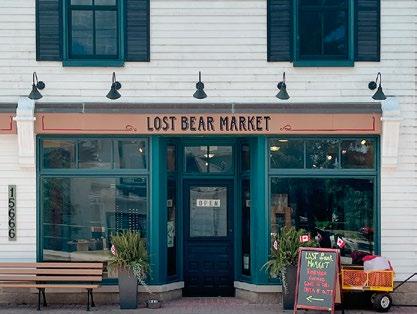



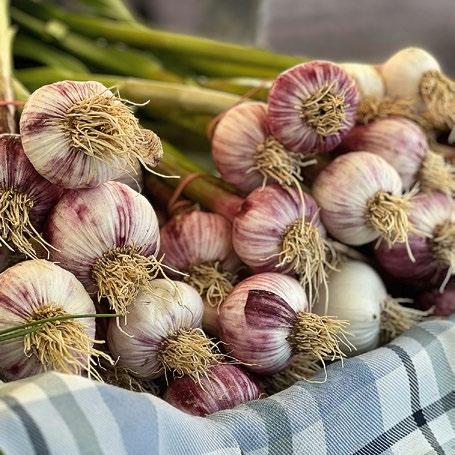

With files from Dyanne Rivers and Signe Ball, and thanks to the staff at BookLore for their invaluable assistance in compiling this year’s book list.

The Christmas Bird Count provides a snapshot of overwintering local birds and an opportunity for birders, experienced and inexperienced, to enjoy some holiday camaraderie.
BY DON SCALLEN
Dan Schuurman speaks to birds. It’s winter 2023 and we are in Alton looking forward to a productive day of birding as we join the Headwaters Nature Christmas Bird Count. At dawn’s first light, Dan whistles a near-perfect rendition of a cardinal’s signature call. And from the edge of the woods, a real cardinal responds. We add “cardinal” to our count list.
A national heritage inventory specialist with Credit Valley Conservation, Dan mimics not only cardinals but also owls and warblers. However, his warbler fluency won’t be tested on this December count day; in winter “our” warblers are flitting around in tropical hardwoods. Nonetheless, lots of birds stay with us throughout the year. And believe it or not, other birds perceive Headwaters as their winter refuge after flying south from the Arctic and the boreal forest.
As the day brightens, we start walking the old railbed south of Queen Street, but we don’t get far. Chirps, tweets and coos signal that birds are all around us. The woodland verges and adjacent meadows are alive with crows, juncos, goldfinches, blue jays and tree sparrows.
Dan hears the thin, high-pitched calls of golden-crowned kinglets and we find four of these tiny waifs foraging in a hedgerow – low enough
for us to look down and marvel at their brilliant yellow caps. Then a wellstocked bird feeder in a Queen Street backyard beckons us. Rival bands of chickadees contest the bounty, trading avian insults with their characteristic chickadee-dee-dee calls. Their fellow travellers, nuthatches and downy woodpeckers, flit back and forth to the feeder, ignoring the dispute.
As we stare at the feeder, Dan mentions that walking around with binoculars near bird feeders and people’s houses can be awkward. “Especially in the early morning, and especially if there’s a bedroom window in the line of sight!” I add. But folks who feed birds are usually quick to intuit our intentions. In this case, a woman steps out her back door and we swap a few bird stories. All good.
Hairy woodpeckers arrive to breakfast at the feeder. Their plumage resembles that of downy woodpeckers, but they are bigger and more robust. Birders look at their beaks to separate the two. Downy bills are small and delicate; hairy beaks are large and chisel-like.
A pair of red-bellied woodpeckers clings to the trunk of a tall poplar and drops down periodically to feed on sunflower seeds. Twenty or so years ago, red bellies on the Headwaters count would jolt even reserved birders
into frenzied excitement. Now, to quote B.B. King, the thrill is gone ... or at least diminished. Birders still enjoy red bellies, but they are no longer rare. Once confined largely to the Carolinian zone in Ontario, they’re now well-established in Headwaters. I train my binoculars on the silhouettes of three medium-sized songbirds perched in a tree in the front yard of the feeder house. They don’t fit neatly into my mind’s Rolodex of expected winter birds. I hesitate to offer an ID. Dan is an expert birder and I’ll feel sheepish if I offer an incorrect guess. But I’m being silly. “I think they’re cowbirds,” I announce. Dan peers through his binoculars and nods confirmation. Good count birds! In the fall these nest parasites generally join songbirds’ mass southward exodus. Most are long gone by Christmas. Headwaters Nature (formerly the Upper Credit Naturalist Club) has conducted Christmas bird counts since 1987. Their “count circle” includes much of Caledon and parts of Erin, Orangeville and Mono. Last year 35 participants were divided into 13 teams to search their section of the circle. Nine people chose to stay home and tally visitors to their feeders. Headwaters Nature data guru Russ McGillivray reports that the mobile teams and the feeder watchers counted


5,304 birds of 50 species.
The Headwaters count is one of 2,000-odd North American counts that take place from December 14 to January 5 every year. The first count, promoted by Frank Chapman of what would become the National Audubon Society in the United States, took place on Christmas Day in 1900 as an alternative to a malign tradition that held sway in the 19th century: spending Christmas shooting as many birds as possible.
That count took place in 25 locations across North America, with most in the northeastern United States. Twentyseven people took part, meaning that most counts were solo efforts. There were two Canadian counts, one in New Brunswick and another in Toronto, where – wait for it – a grand total of four species was tallied!
But from humble beginnings, the Christmas bird count eventually grew into the grand citizen science vehicle it is today. Data from counts in communities across Canada are submitted to Birds Canada and the National Audubon Society in the United States to provide a snapshot of bird populations.
Ron Jasiuk of Headwaters Nature has co-ordinated the count for his club over the last nine years. Standardized count circles measure 24 kilometres in diameter, and the location is the
prerogative of the organizing club or group. Ron explains that the Headwaters count circle was selected to encompass areas offering rich bird habitats.
Like other longtime Christmas count participants, Ron returns year after year for the joy of the search. He recognizes that there is scientific benefit in conducting the counts, especially in discerning long-term trends like the expansion of redbellied woodpeckers into these hills. But like me, he believes no definitive scientific conclusions can be drawn from the counts. Too many variables, such as the weather and the effort and expertise of the birders, change from year to year. Ron, however, sees other reasons to embrace the count. “The great merit of the count is connecting people to the landscape, to nature, and to each other,” he says.
Ron loves the community-building that occurs at day’s end, when tired but excited participants gather to share their finds. “People sometimes don’t know each other, but they arrive energized by a shared project,” he observes. “They swap stories and sightings. I love the buzz!”
And he smiles when younger people get involved. Many participants, including Ron and me, are rather long in the tooth. He talks glowingly about a young University of Guelph student who participated with her boyfriend. “She had a great time,” he recalls. “As a retired high school teacher, I
was delighted. One of my greatest satisfactions as a teacher was stoking the curiosity of my students. I get the same rush from encouraging new birders.”
Ron and I agree that a lack of birding expertise shouldn’t hinder participation in the count. But for those who choose to participate, Ron does recommend doing a little homework – he’s a former teacher, after all – to become at least somewhat acquainted with the birds that might be encountered in winter. The departure of many species in the fall reduces the prospective count birds to a manageable number. And now, free apps like Merlin, from the Cornell Lab of Ornithology, are available to help identify birds.
Ron also promotes feeder watching as an alternative for folks who would rather stay close to home on count day. The task is no more demanding than sitting by a window, coffee in hand, and tallying feeder visitors. Repeat four or five times over the course of the day and the job is done.
If you do choose to participate, don’t take your task too seriously. Have fun. Know that even experts make mistakes. Ron tells a story from an Algonquin Park count he took part in years ago. A team consisting of four eminent Ontario birders heard a high-pitched call they couldn’t identify. It seemed to be coming from the vicinity of an old cabin. The expert birders scrutinized the trees and bushes around the cabin. Puzzled
looks were quietly exchanged, tentative IDs proffered, but the bird eluded them. Then one of the birders opened the cabin door – and found a smoke detector beeping.
Dan and I finish count day at Dragonfly Park in Orangeville. There, in the open waters of the Credit River, we find ducks – mallards, black ducks and common mergansers. Then a pair of belted kingfishers rattles by, careening low over the stream. A great find to cap another enjoyable Christmas bird count. Kingfishers are never guaranteed in winter, but where there’s open water there’s a chance. Their cold weather residency always surprises me. These robust, assertive birds make their living by plunging headfirst into water to catch fish with their beaks, a manoeuvre that demands precision targeting. Difficult, I think, at any time of year, but in icy winter waters? Miraculous!
Winter kingfishers and their hardy confrères evoke wonder and this is one reason birders enjoy the Christmas counts. The thrill of discovery is another. And of course, birds are beautiful and fun to watch.
Christmas turkey with all the trimmings is a treat. But so is a day seeking the company of the wild birds that grace these hills during the holiday season.
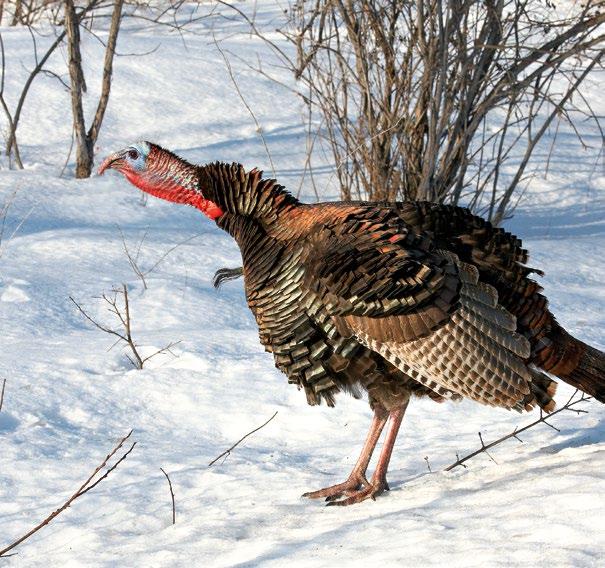
Christmas Bird Count
Here are vignettes describing a few of the 50 species (5,304 birds in all) counted during the event.
1,217
The 1,217 Canada geese far outstripped the tally for any other species. A single Canada goose can weigh as much as 9 kilograms. Assigning an average of about 6 kilograms per goose suggests the aggregate weight of these birds was more than 7 tonnes. Though impossible to prove, this weight of Canada geese probably exceeded the combined weight of all the other count birds.
Unsurprisingly, many of the geese were found at Island Lake in Orangeville. They are waterfowl, after all. But many were also observed in cornfields, feeding on errant kernels from the fall harvest. No doubt this bounty of grain is one reason so many geese overwinter in Headwaters.
Though now abundant, sometimes to the point of aggravation, Canada geese were once scarce in Ontario. Jack Miner, an early conservationist, founded a bird sanctuary in Kingsville in 1904, the year of the first Christmas count, expressly to protect and enhance populations of Canada geese. Obviously, he was successful.
However, Miner was also a man of his day. In his era, predators were vermin, vile creatures meriting extermination. Though lauded as one of Canada’s first conservationists, his “sanctuary” was anything but for those he called “cannibal birds”: owls, hawks, crows and grackles that included songbirds in their diets. These he killed with gusto. Only red-tailed and red-shouldered hawks escaped his ire. Miner considered these “too big and clumsy” to worry about.
Young birders in Headwaters could be forgiven for thinking wild turkeys have been with us forever. They sometimes walk urban streets, for heaven’s sake, strutting their stuff in front of homes and businesses and snubbing their beaks at approaching cars. But these impressive birds, now a common sight in farm fields and woodlands throughout these hills, are relatively recent arrivals, having been reintroduced at various sites in Ontario between 1984 and 1987.
Wild turkeys were eliminated from the province in Jack Miner’s era, in the bad old days of unregulated hunting. The reintroduction of the species, with stock from Michigan and Missouri, has been a resounding success. So much so that



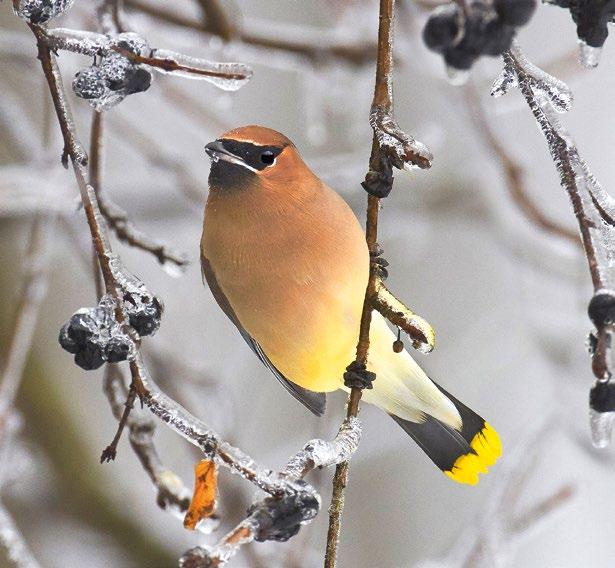
turkeys likely occupy far more territory in Ontario than they did in pre-colonial days, reaching north to the Sudbury and Sault Ste. Marie areas. Like Canada geese, turkeys often forage in agricultural fields during the winter.
And like Canada geese, turkeys can be controversial. Like us, turkeys are omnivores and, as big birds, they need lots of food. Fruit, seeds, nuts, insects are all on the menu. This can put them at odds with farmers. And some conservationists are concerned that turkeys may be scarfing down large numbers of reptiles and amphibians.
Turkeys occupy a strange place in our local ecology. The fact that they are original, native inhabitants means we should welcome them back, shouldn’t we? But nature is nothing, if not complex. The agriculture that supports them now didn’t dominate the landscape in years past. Turkeys have essentially returned to a place foreign to the one they occupied generations ago. Does this render them invasive?
The answer may depend on your point of view. Though turkeys raid crops and may threaten snakes and salamanders, they also offer thrills to naturalists and a challenge to hunters. And all that impressive turkey biomass inevitably recycles back into the environment. Large predators and scavengers are benefiting from the turkeys’ return. On a recent bird count, Ron Jasiuk recalls finding a flock of wild turkeys south of Hockley Road at the 5th Line and 5 Sideroad of Mono. He duly reported the sighting at the end-of-day roundup. Another count participant piped up. He had driven by Ron’s turkey site later in the day. Only one turkey remained, but it was dead and in the clutches of a magnificent golden eagle, a very rare winter visitor to these hills.
AMERICAN ROBIN: 203
The appearance of robins has long been taken as a sign spring is nigh. Birders, however, know that some robins stay in these hills all winter. These winter red breasts retreat from our towns and cities to sheltered areas where they can sip from the open water of streams and forage for fruit. This diet often places them in the company of another common winter frugivore (fruit eater), the cedar waxwing.
Though some robins have always been present in Headwaters during the winter, their numbers are increasing. The 203 recorded during last year’s Christmas count was the highest ever.
Attributing this to a warming climate would be the default explanation. But though climate change may be one driver of the robins’ increased winter residency, other factors could also be at work. The buckthorn, mentioned earlier, that helps support winter waxwings probably also supports robins. When robins are scarce on a Christmas count, I often find them in a buckthorn patch.
So, robins do overwinter in Headwaters, often in high numbers, but for most of us, the adage that robins presage spring will generally continue to hold. When the days lengthen, robins move back to suburbia and sing their familiar song. Perhaps the old saying should be reworked as “singing robins are harbingers of spring.” When we hear their welcome voices in March or April, we can be assured spring is, indeed, around the corner.
BLACK-CAPPED CHICKADEE: 732
Chickadees are among the most endearing of birds and can be trained to land on outstretched palms offering seeds. They are remarkably adaptable, inhabiting the deepest, darkest forests and residential areas alike. Their cheerful calls ring out almost everywhere in Headwaters. Even when the avian pickings are slim during Christmas bird counts, feeders will be aflutter with these friendly creatures. They are insatiably curious, primed to explore new opportunities for food. My late friend, Doris Bourne, who lived in Alton, took a bird feeder with her on camping adventures and loaded it with sunflower seeds. She knew chickadees would soon find the feeder and their chatter would then summon other species.
Winter flocks of chickadees usually travel with downy woodpeckers and our two species of nuthatch: white-breasted and red-breasted. These mixed flocks are believed to offer safety advantages. More birds in winter flocks means more eyes to scan for danger from local bird-hunting raptors such as merlins and sharp-shinned hawks. Chickadees, woodpeckers and nuthatches may also have differing sensory abilities, adding to greater collective wariness.
CEDAR WAXWING: 374
“Dapper” is used so often to describe cedar waxwings that it has become a cliché. But it really is accurate. These are lovely birds, impeccably groomed with tan breasts shading into gold, chic black masks and immaculately coiffed crests. Their red-tipped wings and tails, edged bright yellow, add elegant fashion flourishes.
On Christmas bird counts, it’s either feast or famine with waxwings. They are easily missed because they aren’t randomly dispersed across the countryside in winter. They congeal into flocks that wander the snowy landscape. One team of birders might find a flock containing scores of birds, while birders in an adjacent count area might be shut out.
As frugivores, waxwings scour the landscape for grapes, rose hips and hawthorn


berries. They also feast on the black fruit of buckthorn, one of our most hated invasives. I don’t like buckthorn. It has shouldered aside many of our native shrubs, and if I could, I’d wave a wand and make it disappear. But our antipathy toward this invader shouldn’t blind us to the fact that waxwings and other overwintering birds benefit from it. Its sheer abundance means it likely offers more food to birds in winter than any native shrubs or trees. And those birds signal their allegiance to this invader by dispersing it through their droppings.
NORTHERN CARDINAL: 51
My childhood overlapped with the life of a man who lived in Toronto in the 1920s. We were brought together by our mutual love of nature. He told me of his delight when, as a young man, he spotted a cardinal. So rare were these birds in Toronto at that time that he would report sightings to the Royal Ontario Museum. According to the second Atlas of the Breeding Birds of Ontario, cardinals did not likely breed in Ontario before European settlement. The first Ontario nest was found at Point Pelee in 1901. The first Toronto nest was found in 1922.
Over the past century, cardinals have progressed steadily northward and are now common throughout Southern Ontario. Like chickadees, they are beloved. A brilliant red male cardinal perched in the snow-dusted boughs of an evergreen is a beautiful thing. For those with discriminating taste, the tan-coloured females also offer beauty, albeit of a more subtle sort.
Much of the movement of cardinals northward in eastern North America happened before the climate warmed substantially, indicating that automatically invoking climate change as the cause of bird-range expansion does not always pass muster. The northward movement of cardinals may have more to do with the proliferation of bird feeders in residential yards. Cardinals are very fond of sunflower seeds, which they crack with their impressive bills.
Birders know that if they spot a female cardinal, a male will almost certainly be close. Cardinals stay coupled throughout the year, and solicitous males will often strengthen their bonds by passing seeds to females with their beaks.
Thinking of bundling up and joining this year’s Christmas bird count? Find out how on Headwaters Nature’s website: onheadwatersnature.ca.
Don Scallen is the author of Nature Where We Live: Activities to Engage Your Inner Scientist from Pond Dipping to Animal Tracking. Read more of his observations on local flora and fauna in “Notes from the Wild” at inthehills.ca.
Your home’s air can be up to five times more polluted than outside air.1 Schedule an appointment today to learn how we can help you take steps toward achieving healthier home air.
Air Purifier Kills or makes inactive 99% of common cold, influenza, strep throat and coronavirus particles trapped on the filter.2
Ventilator Brings fresh air into your home without common indoor impurities.
Humidity Control Balances humidity levels inside your home to help prevent environments where mold and bacteria grow.
UV Lights Help prevent mold and bacteria from growing on our system’s cooling coil.
1 2 bryant.com/en/ca/before-you-buy/indoor-air-quality


519-806-4911


Weekender, former resident, regular visitor? Receive In The Hills wherever you live. Subscribe online at inthehills.ca/subscribe or by calling 519-216-9894.


Caledon’s Zoe Boyd grew up on the ice, but even as an exceptional player her career options in women’s hockey were limited. Then she got drafted by the brand new Professional Women’s Hockey League.
BY ANTHONY JENKINS
It is early fall and balmy, still shorts and T-shirt weather. Few are thinking about hockey.
But Zoe Boyd is. As she heads home to Caledon from an Etobicoke rink where she and other women players in the GTA enjoy regular, off-season scrimmages, she’s searching for an answer to a question I asked.
“The Isabella Cup?” the 24-year-old

answers and questions simultaneously. She’s guessing the name of the championship trophy awarded to the winning team after last winter’s inaugural season of the PWHL, the Professional Women’s Hockey League. She’s mistaken about the name of the trophy. It’s the Walter Cup. Her team, Ottawa (now renamed the Ottawa Charge), finished fifth in the
standings and missed the playoffs. Minnesota won.
Zoe herself missed the end of the season, out with an injury. She may be remembering one of the other championship trophies and awards she has won in the past, the ones she says are “probably buried in the basement” of the family home in Caledon East. But now, as she suits

up for her second season in the PWHL, the name of the ultimate prize is burned into her brain.
A professional career – nay, stardom –in the NHL is the dream of every redblooded Canadian boy with a helmet and a hockey stick. But not any girl. Until recently, there was no professional league to inspire a young woman’s on-ice ambitions. With the advent of the PWHL, all that changed.
The PWHL, a professional hockey league based in Canada and the United States, will open its 2024–25 season of regular play at the end of November. Along with Ottawa, the league’s six teams include Montreal, Toronto, New York, Boston and Minnesota.
For the inaugural 2023–24 season, the best women hockey players, both in North America and internationally, were signed up. Nearly all the women who played on Team Canada and took home gold at the 2022 Olympics and the 2024 World Championships are in the league. Brianne Jenner, Emily Clark, Ashton Bell and Emerance Maschmeyer are Zoe’s teammates in Ottawa.
The first 24-game season was played to enthusiastic crowds of unprecedented size for women’s hockey. On April
20, 2023, a sold-out crowd of 21,105 watched a game between Toronto and Montreal at the Bell Centre in Montreal, the largest attendance ever recorded for a women’s game, anywhere. The number of regular season games per team has increased to 30 this year and all the games will be broadcast live on television or streamed.
“The PWHL is really special. It feels much bigger than a game,” Zoe says. “At the home opener in Ottawa last season … I don’t have words for what it felt like. I step on the ice for warmup. The crowd is roaring. You look up and there is not an empty seat to be had. Everyone is on their feet. That was probably the highlight of my career. It wasn’t a fancy goal or a win. Just that. It took my breath away, brought tears to my eyes. I felt an overwhelming sense of pride. It is something I never thought I’d see in my game.”
No hockey player, no elite-level player of any age or gender can make it to the top unaided. Could Zoe, on talent alone, have made it to the pros?
“Certainly not,” she says. “If you don’t have the resources and support, it is next to impossible.”
Moms and dads sipping endless hot
coffees in a numbing succession of cold arenas may eventually find themselves watching their offspring play highlevel youth hockey. But it doesn’t come cheap. Once equipment, registration fees, paid coaching, ice time, travel, and accommodation at out-of-town tournaments are factored in, costs can climb into many thousands of dollars a year.
Parents should also plan on attending a minimum of two games and two practices a week, eight months of the year, or more. Yelling encouragement from the stands is free.
Zoe remembers her own parental support and is reminded that her mother, Tammy Thomson, was an enthusiastically vocal presence in the stands while they watched her brother play. Was. Her mother was involved in a catastrophic auto accident when Zoe was five. Now in a wheelchair, she lives in a Brampton long-term care facility.
“She has severe brain damage. I don’t think she knows I’m playing professionally. You can tell her, but she can’t really grasp or retain that information. Still, I know from everything people have told me she would have been extremely, extremely proud.”


In the coming season, Zoe’s mother will be taken to the Coca-Cola Coliseum on the CNE grounds to watch a PWHL game between the hometown Toronto Sceptres and her daughter’s Ottawa Charge.
“My dad will be sitting with her and reminding her that I’m out there. I think it will click for her. If not, I’ll see her afterwards, all sweaty, and she will definitely know then. It will be special.”
Zoe’s journey toward a professional hockey career began at age three, when she was enrolled by her parents, without much enthusiasm on her part, in a hockey school alongside her elder brother, Spencer.
Playing road hockey, pond hockey and on hockey teams based in the Caledon East Community Complex followed. All competitions at that time were with, and against, boys. Girls –Zoe was often the only girl – changed
in the referee’s dressing room. Zoe persevered. She became enthusiastic. She got good.
“When I switched over to girls’ hockey (at age 12 or 13), I didn’t play in Caledon. I played in Brampton. There wasn’t any high-level girls’ hockey in Caledon then. It was often just me and Kristin.
“Kristin” is Kristin Della Rovere, another Caledon hockey success story. Kristin lived just doors away from Zoe. They met at about age four, two energetic girls who bonded immediately.
“My dad played hockey,” Kristin recalls. “He loves the game. He tried to get me into hockey with little success. Then Zoe, my best friend, was playing hockey, and I wanted to play with her. I asked my dad to sign me up. He was ecstatic.
“Zoe is more than just a friend, she is like a sister to me. We have respect and love. We’ve experienced trauma together.” After Zoe’s mother’s lifealtering accident, Kristin’s mother,
Elizabeth Dimovski, stepped up both at the rinks and off-ice, becoming something of a second mother to Zoe.
Kristin and Zoe played together on the same boys’ hockey teams, then on all-girl teams, excelling and sharing the same dreams of making it to the top.
During many an aspiring young woman’s late teens, the “top” meant four years as a college athlete on a hockey scholarship in the U.S. For most, opportunity in hockey beyond that would be beer league or nil.
Kristin, pursuing medicine, went on to Harvard, playing hockey there with the Crimson.
Zoe went to Quinnipiac University (“Near Yale,” she says. “No one has ever heard of it.”) in Connecticut on a full scholarship, majoring in sociology with minors in sports and gender studies. She played four years for the Quinnipiac Bobcats, rising to become team captain.
Then what? “The future? Let’s just say I was very lucky to be drafted (into the PWHL). It was always hockey. If I
wasn’t drafted, I’d have probably gone overseas to play.”
“I had graduated and was in New York at a friend’s parents’ house trying to figure out what my next moves were,” Zoe remembers. “I watched the PWHL draft (live-streamed on CBC Sports). It took place a nine-hour drive away in Toronto, and I honestly didn’t think I was going to be drafted, so I didn’t go.”
But she was drafted – 53rd by the Ottawa team. “When I heard my name called, I screamed! I jumped! I cried! It was pure happiness. It was one of the coolest moments of my life.”
It got cooler. Kristin was drafted 56th. Also by Ottawa.
“I was hoping to be drafted, but it was not something I was expecting,” Kristin says. “I remember Zoe’s name being called. My whole family was excited and was texting and calling her, texting and calling me. I was calling her. When my name got called a few people later, we were still celebrating Zoe! I almost missed myself being drafted. We were both
so shocked and grateful.”
In Ottawa, that first season, the parallels continued, unfortunately when each sustained an injury.
By halfway through the season, Kristin was out with torn ligaments in her left wrist. Within a couple of weeks, pal Zoe broke her left wrist, also requiring surgery. “The odds of that seem impossible,” Kristin muses. Both sat out the remainder the season.
Zoe, repaired, has returned to Ottawa. Kristin signed a one-year contract with the Bolzano Eagles, a professional team based in northern Italy. “Exploring pro hockey in another country is something I could not pass up,” she says.
She has hopes of representing her family and Italy in the 2026 Olympics. “I’ll miss Zoe. She still spends quite a bit of time with my family. In Ottawa, on ice or out with surgeries, we saw each other every day. Now she is halfway around the world...”
Playing professional women’s hockey involves home and away games, travel, practices, off-season conditioning, and unceasing, competitive pressure to perform at the highest level – ideally at a higher level than the opposing team – every game.
The remuneration, though a fraction of that paid to NHL stars – or even NHL bench-warmers – is a decent living wage with benefits such as performance bonuses, stipends for accommodation and food at home, and on the road, all meals and hotel expenses covered.
All of which makes it seem like a fine job.
Is it a job?
Says Zoe: “It never feels like a job. A better word to describe it would be a privilege. It is something all of us who do it have been doing our whole lives because we love it. Bad game, bad loss, hard workout, it never feels like a job. I’m lucky to be able to say that.”
Thirty to 45 seconds. That’s the length of a typical over-the-boards, go-full-out, then-get-off-the-ice shift in professional hockey. As a defender, Zoe’s main role isn’t putting the puck in the net. In fact, she has yet to score
her first goal as a professional. Her job is making sure the other team doesn’t put pucks in her team’s net.
Asked to describe her ideal shift, she envisions no highlight reel of dazzling dekes, blistering shots, or lifting a crowd to their feet with a spectacular score. “I see a calm, cool, composed shift where I’m in control of the play, creating lots of movement. Making a difference. Being a presence.”
In hockey, even in women’s hockey where body checking is prohibited, or limited (as in the PWHL, though the rules include some grey areas, says Zoe), being a physical presence is required, almost demanded. That is not in Zoe’s nature. Yet.
“Yes, it’s very physical,” she says. “There are some big hits. You have to keep your head up. We’re not used to that. In college, there is no body contact. It’s a big adjustment. I’m okay with the physical stuff. I’m getting stronger and getting used to it. It’s a lot of fun.”
Fun and familiar is fine, but is more required in the pros? Does competitiveness demand a dollop of mean?
“Yes, definitely.” Zoe responds, “You need an edge. I wasn’t born with an edge. I’m naturally chill. I don’t get angry. But it’s hockey. It is rough and tough out there. I need to do some selftalk to get into that mindset. You can get a little mean but still be respectful.”
Zoe is young in a young, burgeoning professional league. Will she still be patrolling blue lines, controlling the play, creating movement, honing her edge 10 years from now?


“I hope so. Hockey has been a big part of my life. My whole life. If I’m still involved in the game in one way or another at 34, or beyond, it would not surprise me.”
Wearing Ottawa jersey number 3, Zoe is eager to give her all for a career in hockey and maybe to hoist the PWHL trophy, the name of which she now knows.
Anthony Jenkins is an artist, writer and beer league hockey player. He still harbours a decades-long hope of being drafted by the Toronto Maple Leafs.









HITTING THE TRAILS AFTER DARK DURING WINTER TRANSFORMS A COMMON DAYLIGHT PASTIME INTO AN AWE-INSPIRING OUTING
BY ANNA LEE BOSCHETTO | PHOTOGRAPHY BY ROSEMARY HASNER
It’s a chilly Saturday night in late January. But instead of popcorn and a movie, my partner, Chris Bean, and I decide to venture out for a winter night hike. We find ourselves in a lineup of vehicles entering the Terra Cotta Conservation Area, 485 sprawling acres of the Niagara Escarpment on the southwest border of Caledon. Sure, such lineups are a common sight at the height of summer or during fall leaf-viewing season, but in the depths of winter?
Check websites for nighthiking, skiing and snowshoeing events and hours.
Terra Cotta
Offering a schedule of events throughout the seasons, Credit Valley Conservation invites outdoor enthusiasts to embrace the magic of winter on many of its trails. Ignite the Night runs every Saturday from January 4 to March 1 at Terra Cotta Conservation Area with a 2-km illuminated trail open from 5 to 9 p.m. cvc.ca/events
The Mansfield Outdoor Centre has dedicated hiking and snowshoe trails for visitors to explore more than 200 acres at their own pace. This winter, they have connected their trails with a segment of the Dufferin County Forest, offering about 60 km of additional doubleand single-track for skiing, fat biking and snowshoeing. Those who want to venture out at night should bring their own headlamps or flashlights as trails are not lit. mansfieldoutdoorcentre. ca/about-trails
Creemore
Private tour operator Step It Up Adventures offers a guided 3.5-km hike into the Singhampton Caves and a longer 5.5-km hike through the Nottawasaga Bluffs Caves, among other options. stepitupadventures.ca
Mono
Mono Nordic Ski Club in Monora Park is open seven days a week for cross country skiing with 2 km of lit trails that stay open until 9 p.m. Join as a member or buy a day pass, which lets you access the entire 16-km trail system including night skiing. Winter hikers can hit the trails at Mono Cliffs Provincial Park or the Hockley Valley Provincial Nature Reserve, both of which host sections of the Bruce Trail. townofmono.com/about/hiking
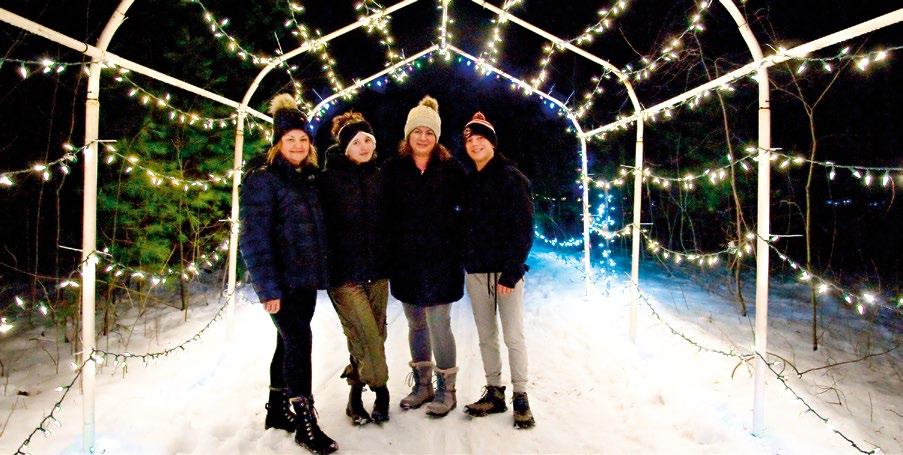

ABOVE AND PREVIOUS: Hikers enjoying one of the trails at Terra Cotta Conservation Area last winter, which, come January, will again be home to Ignite the Night, an illuminated night-hiking program, complete with light installations, torches and a cozy firepit.
We’re both originally from Northern Ontario and find solace in long winters by embracing the outdoors, but this is a first for us. We are pleasantly surprised by how many others are here, in the dark, bundled up and ready to go – many with headlamps. It’s shortly after 7 o’clock and we’re all exploring a twokilometre illuminated trail – part of Credit Valley Conservation’s Ignite the Night program. The last entry time is extended to 8 p.m. with a closing time of 9 p.m. It’s free, aside from the park entry fee.
As we set out, the air is crisp and refreshing. The snow glitters under the light of our headlamps and a peaceful stillness envelops us. It is a sensory journey unlike any other. The night sharpens our senses; every crunch of snow underfoot is amplified, and the darkness transforms the familiar landscape into something magical.
Lachlan McVie, a night hiker and backcountry canoer I connected with before our hike, helped explain the allure of night hiking to me. “Since we had kids, night hiking has become a must for us,” the Alton resident explains. “In winter, it gets dark so early that you either head out or miss out entirely.” For Lachlan, what began
as a necessity quickly turned into a cherished tradition. He notes how being out in nature offers a break from the daily grind and a refreshing sense of calm.
As we venture deeper into the trail, the atmosphere shifts as we encounter five light installations, each showcasing a specific tree species: red oak, hemlock, sugar maple, American beech and willow. These artistic displays not only light our path, but also deepen our appreciation for the diverse flora around us. The first half of the trail is adorned with twinkling lights that evoke a fairytale-like ambience, while the second half, illuminated by tiki torches, offers a more rustic feel.
“Winter night hiking is an incredible adventure,” says Emily Quinton, president of the Alton Grange Association, which manages a 350acre tract through which Shaws Creek and the Credit River flow. “It’s less busy, plus, there are no bugs! There’s something really cool about seeing the landscape through all its natural changes.”
Emily has been an all-season hiker for years and recalls her early adventures on the Bruce Trail with her grandparents. “They jumped into it with both feet and that was part of my inspiration,” she says. “Now in my free time I volunteer to lead seasonal hikes in the Alton Grange. We’ll
set up bonfires and do two guided hikes each season.” She recommends that readers follow the association on social media to find out about upcoming hike events.
The lack of foliage makes even familiar trails seem novel, Emily says. “You see everything in a new way. If there’s water, you can spot birds and beaver activity that you might miss in the summer. Plus, the trails are so accessible now that many libraries rent out hiking poles, and some conservation areas offer snowshoes and skis for rent.”
Indeed, one of the goals of events like Ignite the Night is to remind nature lovers that they can – and should! – cross-country ski, snowshoe and walk trails they’re used to traversing long before the snow flies, even if they have to plan their own itinerary. At various intersections along the Caledon Trailway, for example, visitors can pair an evening hike with a hot chocolate stop in a nearby village.
Gazing upward on my hike, I marvel at the twinkling stars that seemed to shimmer even more brightly against the winter backdrop. Every sound – snow squeaking, trees creaking, the whisper of the wind – is heightened in the stillness. I make a mental note to return with my teenage daughters, hoping to share this extraordinary adventure with them.

As Chris and I stroll, he points out notable signs of wildlife. His keen eye for details reminds me of my conversation with Lachlan: “Night hiking isn’t just about the hike. It’s also about reconnecting with nature.” Lachlan also emphasizes how essential these moments are for our mental clarity and connection to the world around us. “Without daylight as your guide, your senses take over,” he notes. At first, this shift can feel unsettling, but once you let your senses adjust, it feels profound.
And though I appreciate the solitude of the hike, the camaraderie of fellow hikers is equally rewarding. As we pass families and couples, short conversations flow easily, punctuated by shared moments of awe at the installations along the path. We were all part of an exclusive club, united by our love for the outdoors.
Preparing for a winter night hike doesn’t require a hefty investment. “If you’re starting out, you don’t necessarily need winter hiking boots,” Emily advises. Regular boots can work well since you’re not as hard on your footwear in the snow, she says. “Ice cleats are also a great investment –they can be as little as $15 and make a significant difference when you encounter icy patches.”
Lachlan recommends bringing two headlamps, a backup flashlight and extra batteries. “You can find
headlamps at hardware stores and it’s always good to be prepared,” he adds.
As we finish our hike, we gather around a cozy firepit near the park store, where guests can purchase small souvenirs like stuffed animals and books about local wildlife. We indulge in hot chocolate and unwind with fellow adventurers. The warmth of the fire adds to the sense of community.
Steve Fisher is a hiking leader with the Oak Ridges Trail Association, which organizes hikes year-round along the Oak Ridges Moraine, a 200-kilometre ridge that runs from Caledon’s Niagara Escarpment in the west all the way to the Trent River in the east, and includes places like the Palgrave Forest. “Winter on our trails is a whole different expedition,” the Schomberg resident explains, echoing Emily’s perspective. “Without the density of foliage, you see everything differently. The landscape transforms and the absence of mosquitoes makes winter the ideal season for hikers.”
For me, the fresh air, the crackle of snow beneath my feet, and the magical interplay of moonlight and starlight made my chilly hike both calming and invigorating. I’ll be back.
Anna Lee Boschetto is a freelance writer living in Bolton.
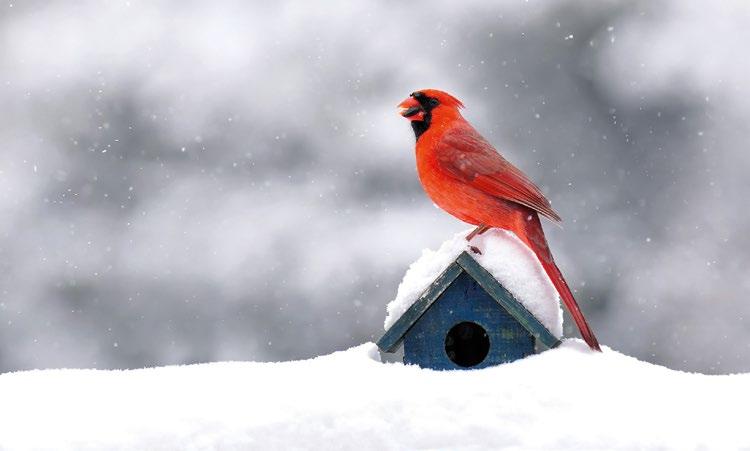



BY EMILY DICKSON


With flavours that hint at the street snacks of Wuxi, China, Hong Kong night markets, and Shanghai cafés of long ago,
The Pine’s prix fixe tasting menu of 14 to 18 artfully named dishes weaves a rich tale.
The Creemore restaurant’s offerings include their signature plate, the French Concession, named after colonial Shanghai’s French settlement. It features sourdough roasted in brown butter and a kabayaki glaze (based on a Japanese
soy sauce glaze), with foie gras ice cream, sour prune jam and foraged meadow wood sorrel. Using the Italian acqua pazza method of poaching seafood in something acidic (in this case an aged rhubarb vinegar), Scallops in Crazy Water is garnished with goat-butter Béarnaise, sea buckthorn emulsion, black garlic, and fermented apple jam and elderberry capers. Pumpkin Cake is a crispy pumpkin wafer filled with caramelized onion,
pumpkin and St. Albert aged cheddar crema, glazed in birch syrup and corn spice – a riff on a popular Chinese treat, Nan Gua Bing. The menu is constantly evolving — expect novelty with each visit.
Owner and head chef Jeremy Austin took a gastronomic gamble when he opened The Pine, his first restaurant, drawing on his time working as a chef in China. It’s paid off, first by landing on Canada’s 100 Best Restaurants, Bars and Chefs list three years in a row, and then again this September when it became the first restaurant in this region to be awarded a Michelin Star.
“One of the beautiful things about getting the star is that we were never that confident to talk about the food we make, but now we’re sharing details about the Chinese influence and the story of each dish because that’s what got us the star and that’s what customers find intriguing,” explains Jeremy, whose culinary training at George Brown College took him to Italy and later to jobs in the Far East. “We lean heavily on Chinese ideas inspired by French cuisine, but work with the Canadian seasons so we can use what’s fresh from the farm and the kitchen.”
Consider booking the Chef’s Counter, a communal table facing the kitchen where you can observe Jeremy and sous chef Owen Pearson in action.
MARK YOUR CULINARY
Unleash your inner winemaker at the Blend Like a Pro workshop at Adamo Estate Winery in Mono on January 15. “This is perfect for any wine lover who wants to learn by doing in a fun and informative session,” explains winemaker Vanessa McKean. “We’ll taste wines aged in different barrels, and then add your own winemaker flair by blending a bottle to take home.”

Learn how to twist the perfect salami rose and artfully arrange cheese, crackers and more at the Cheers to Charcuterie workshop at the Grand Valley Public Library on December 21, led by Grand Valley-based Veronica Vijay of On the Board.










Jars of homemade strawberry jam, sweet summer relish and fresh pickles are some of the goodies you’ll find in carefully curated Holiday Collection boxes from Grand Valley food star Rebecca Landman’s new venture Rebecca’s Kitchen. They include a booklet filled with Rebecca’s writings and favourite recipes. Order online for delivery or pickup. Using what they call “weird apples, conventional apples and boring apples,” donated by friends and neighbours, Heartwood Farm & Cidery in Erin makes just a few hundred bottles of their

Whether as a gift or an edible table setting, the work of local chocolatiers wows both the eyes and the tastebuds. Nestled among chocolate poinsettias and white chocolate angels, one item stands head and shoulders above the rest at The Chocolate Shop in Orangeville: a one-foot-tall Santa, available in milk or dark chocolate. An intricate milk chocolate holiday fireplace complete with ornaments and stockings from Creemore’s YF Patissier-Chocolatier hides a surprise. Lift the fireplace to reveal eight different handmade ganachefilled bonbons hidden inside. And while Ginger Molasses, Candy Cane and Toblerone cookies are seasonal specialties at Wicked Shortbread in Orangeville, for a bolder bite sink your teeth into their stuffed Baileys Buttercream Sammies.


Community Harvest cider every year, proving that when it comes to apples, beauty isn’t skin deep. Look for Orangeville-made Albert’s Leap soft ripened cheeses, including double cream Brie and goat Brie, available at More Than Just Baskets on Broadway in Orangeville. They also sell Brie-baking dishes and topping kits. Topped with pecans, rosemary or honey, velvety baked brie is a crowd pleaser. Ditch the salt and pepper and embrace flavours like Piri Piri, Smoke Eater and Veggie Blaze at Fire in the Kitchen’s new Orangeville retail shop, which makes an innovative line of dry rubs, sauces and marinades.
A chic, delectable holiday fireplace by YF Patissier-Chocolatier in Creemore, above, meets a folksy chocolate Santa, left, from The Chocolate Shop in Orangeville.
Below, an Orangeville-made Brie, Albert’s Leap, pairs nicely with a gift basket from Rebecca’s Kitchen, starring her handmade jarred goods.

The Rosemont General Store and Kitchen is ready to take away the stress of Christmas dinner with a choice of sliced cooked turkey and ham or cook-at-home beef Wellington, paired with rustic mashed potatoes, sautéed buttered cabbage and brown butter carrots – plus stuffing, gravy and cranberry sauce. Fresh turkeys are also available for home cooking.
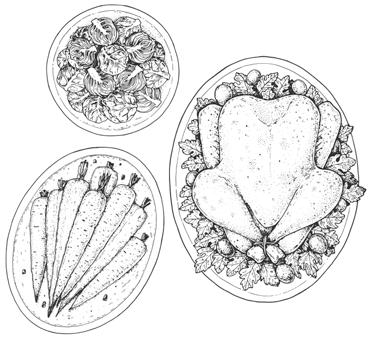
yAt Creemore Roastery Café, owner Louise Priest is having fun building a menu of street food from around the world that reflects the many coffeegrowing nations she sources her beans from. Take her popular Banh Mi, a crunchy Vietnamese sandwich filled with chicken marinated in char siu (a barbecue blend), cucumber, pickled carrot and daikon radish, greens, cilantro and a touch of spice. “Every once in a while, you put something together and you know it’s gonna be good,” she says.




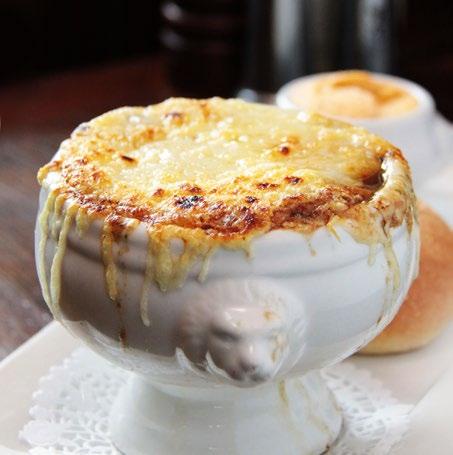




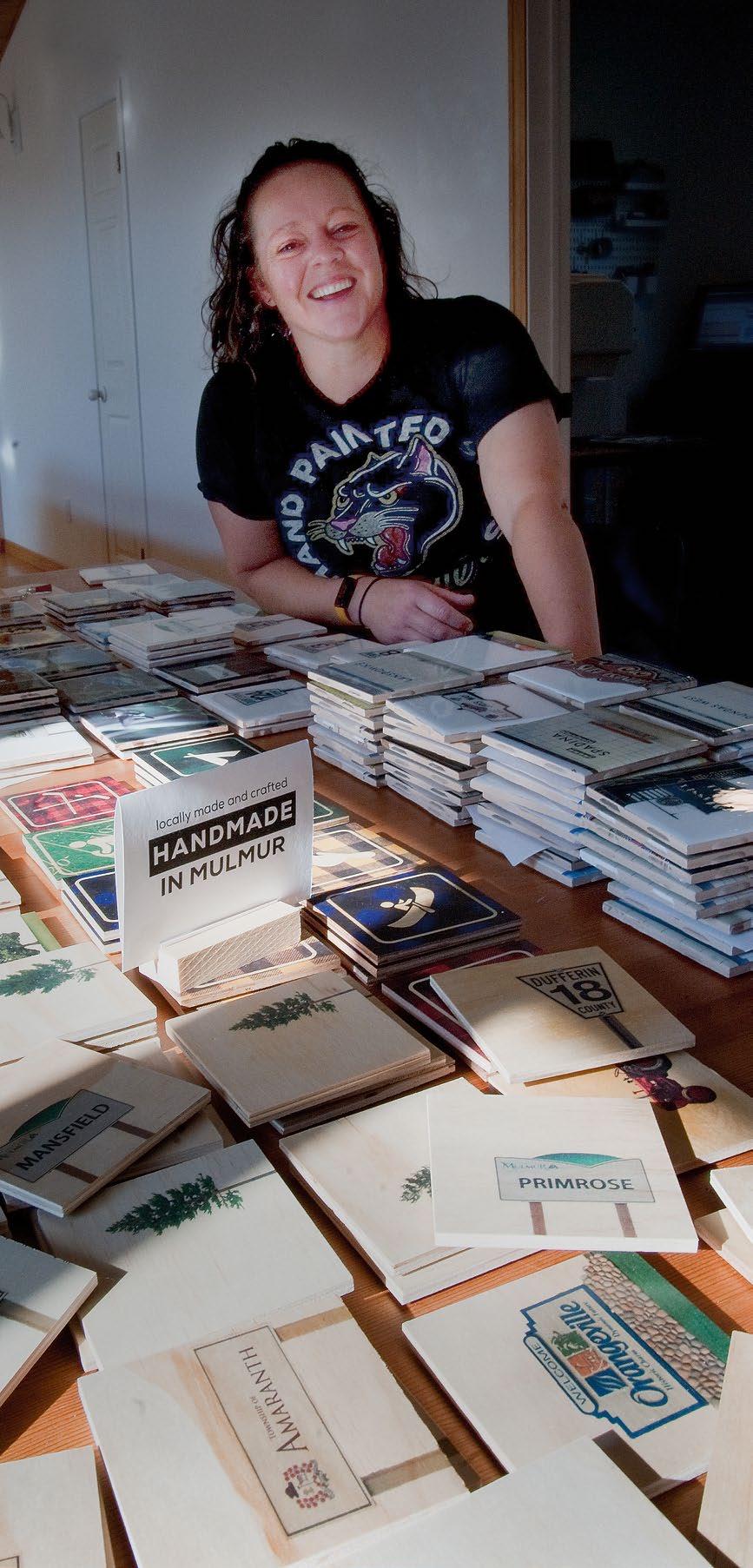
Mulmur printmaker Nicola Kidd captures tractors, raccoons, street signs and even the CN Tower on whimsical wooden coasters, magnets and postcards.
BY EMILY DICKSON
“I’M KIND OF OBSESSED WITH SQUARES –not sure if you noticed that,” laughs Nicola Kidd as she shows me a worktable strewn with dozens of colourful prints on thin squares of wood. The Mulmur artist typically uses unfinished birch or fir to make her eye-catching fridge magnets, coasters, wooden postcards and wood canvas prints. Her images of choice? These days, quintessential scenes of local country life inspired by her love of the outdoors and nearby landscapes.
But as earthy as the final products appear, today’s technology – in the form of an industrial inkjet printer – plays the key role in transferring Nicola’s images onto sheets of wood as though they were paper. She sells her finished wares under her Resurfaced label.
The former urbanite, who originally hails from Calgary, spent a decade in Toronto studying, teaching and working in digital print. She now works out of a studio in the home she shares with her filmmaker partner, Sean Sealey, and their two small dogs, Waffles and Maybe.
Nicola begins the process with photography, capturing specific images she wants to miniaturize. She then digitally removes the backgrounds, often keeping the shadows where they fall to add depth. Next comes the preparation of the wood. Because the surface must be perfectly flat for the printer to make proper contact, she uses a table saw to cut new wood to size. Many small pieces, such as magnets and coasters, can be printed simultaneously, while the largest size, about 14 by 12 inches, is printed one at a time. “I love working with wood. Each piece comes out a bit differently based on the colour and grain, so it’s interesting to see the final result.”
The wooden pieces are then placed in the printer and the images are printed directly onto the wood.


Because the natural beauty of the wood shines through, the effect is subtle, but striking. Next the ink is cured, or hardened, onto the wood by the printer’s UV light, and Nicola ends the process by protecting the finished pieces with a light coat of varnish.
Though customers have the option of mixing and matching their own set, some of the pieces are organized into themes. The Mono coaster set includes rural icons such as a barn, a horse crossing sign and a sign for Mono Cliffs Provincial Park, while the Ontario Hiking set features Bruce Trail blazes and a wild grouse. Tractors, canoes, geese and a family of raccoons all make appearances in her collection, as do signs for local roads such as Highway 10 and Highway 89.
Nicola is also fond of capturing town entrance signs, which she feels exude small town pride. “I do like seeing people’s eyes light up when they see the squares. They’ll tell me they grew up in Grand Valley or they live in Mulmur … I think it’s fun for them to see their local life captured in art,” she says.
Other sets focus on well-known Toronto spots, including subway stations, streetcars and classic buildings such as Massey Hall. She sells these at Uppdoo, a boutique in downtown Toronto.
“These images evoke a lot of reactions too,” Nicola says as she describes her early days selling Resurfaced products at Toronto
markets. “People would pick up a square with Honest Ed’s on it and I’d think, Here comes a great story! They’d tell me about arriving in Canada as a newcomer and buying their first frying pan there. The squares are small, but they seem to really capture and evoke the memories of a place.”
Since moving to the country, Nicola’s subjects have evolved with her. Huge fans of mountain biking, she and Sean are now able to spend more time on the trails at Mansfield Outdoor Centre and enjoy the serenity of being surrounded by nature. “Coming here really feels more like home than Toronto ever did,” she reflects. “I loved the stories people had about old buildings in Toronto. But for me it’s always about nature. I’d rather be outside than in a building.”
Find Nicola’s work at resurfaced.ca. She is also one of the many vendors whose work will be available from November 27 to December 8 at the Museum of Dufferin’s annual Holiday Treasures Craft Market. Her work is also for sale year-round in the museum’s gift shop.
Dickson
Orangeville.




Call for a Free Market Evaluation to find out what your property is worth in today’s market



BY JANICE QUIRT
Darlene Hostrawser is the Mono artisan behind Handwoven Cloth Culture’s richly hued hand-woven blankets, shawls, scarves and table linens. Wool appears in wraps, while cotton and linen work best for placemats, runners and tablecloths. “These are fabrics you will want to wrap yourself in or elevate the at-home dining experience with,” says Darlene. (Table linens $40 to $200, Holiday Treasures and Handwoven Cloth Culture)
Working primarily with wheel-thrown porcelain, Orangeville potter Valerie Moore of Wishing Stone Pottery punctuates her clean, contemporary aesthetic with pops of colour, mostly blues, often as hand-drawn whimsical sketches. “As an avid rower, I have a strong connection to water and a deep appreciation for its beauty,” Valerie says. “This inspires the surfaces of my work, from varying depths of blues to representing surface patterns with lines and circles.” (Vases $25 to $85, cups and mugs $30 to $45, Wishing Stone Pottery)





Orangeville crocheting and knitting whiz Tania Da Costa stocks her line, Homespun Knits, with the sweetest stuffed animals, purses, lovies and cold-weather beanies. “My passion is creating detailed, well-made pieces that inspire imagination and comfort. Each piece is as special to me as they are to my clients.” (Animals $45 to $65, Homespun Knits)
Carolyn Metzger of Willow Brook Waterfowl & Fiber in Amaranth felts handmade dryer balls that help fluff your laundry sans dryer sheets or fabric softener – while shortening drying time. The secret? Fibre from the alpacas the family raises on their farm. (Set of three alpaca dryer balls $25, Willow Brook Waterfowl & Fiber)




Dufferin Foraged Inks comprises creative duo Fabienne Good and Darlene Hostrawser. Each grew up on farms in Dufferin County and in addition to separate pursuits (Fabienne’s woven paper baskets, featured in our last issue, and Darlene’s shawls and table linens, left) they now harvest and produce inks made from foraged biological materials. Alongside the inks, they also sell hand-painted cards and postcards made with the inks, as well as hand-painted wooden ornaments and postcard kits. (Cards $6 to 15, Holiday Treasures and Dufferin Foraged Inks)

Each candle from Flights of Fancy Honey Bee Company in Loretto is made from 100-per-cent pure beeswax and fitted with a cotton wick for a clean, natural burn. The holiday collection includes tea lights, pine, spruce and holly trees, fairy and casted balls, and more. Owner Stephanie Wilding lets us in on a little holiday secret: “Every item in our holiday collection comes with a special tag featuring a QR code, so you can ‘Meet the Bees’ that made your candle.” That’s a flight even more magical than Rudolph’s journey! (Trees $4.75 to $22, balls $12 to $25, Holiday Treasures and Flights of Fancy Honey Bee Co.)

Dufferin Foraged Inks, Mono. IG @dufferin_foraged_inks
Flights of Fancy Honey Bee Company, Loretto. flightsoffancyhbc.com
Handwoven Cloth Culture, Mono. IG @handwoven_cloth_culture
Holiday Treasures Crafts Market (November 27 to December 8), Museum of Dufferin, Mulmur. dufferinmuseum.com
Homespun Knits, Orangeville. IG @homespunknits
Willow Brook Waterfowl & Fiber, Amaranth. willowbrookwaterfowlandfiber.com
Wishing Stone Pottery, Orangeville. IG @wishingstonepottery








GENERAL CONTRACTING
Interior & Exterior Renovations
Design/Build Garages & Additions
TREE SERVICES
Tree Removal & Pruning
Stump Grinding & Lot Clearing
LANDSCAPING
Design, Build & Install
Retention Walls
Interlock & Natural Stone
SPECIALIZING IN
Land Restoration Services
Septic Systems
Grading & Excavations
Helical (Screw) Piles
Armour Stone Installations



If rising fuel costs and environmental concerns have you considering a heat pump, here’s how to decide if one is right for you.
BY ALISON McGILL • ILLUSTRATED BY RUTH ANN PEARCE
HEAT PUMPS ARE NOT NEW TECHNOLOGY –they were created by an Austrian scientist in the 1850s – but there is currently a lot of buzz about their advantages over fossil fuel-based or electric heating and cooling systems. Heat pumps can have a lower environmental impact, lower cost – and homeowners can be eligible for government rebates.
Heat pumps consume less electricity and deliver more energy than a traditional furnace, explains Graham Bryan, who along with his sister, Laura, and father, Roy, is co-owner of Bryan’s Fuel in Orangeville. “These systems are fit for almost any home as they come in different varieties that can work with, or without, ductwork. A heat pump system can even be integrated into older homes with hot water heating systems.”
How heat pumps work
The most common type of heat pump has a splitunit system, with an outdoor and indoor component connected by two refrigerant lines. The heat pump uses a compressor to move a refrigerant through the refrigeration cycle in one of two directions.
This means heat pumps are dual-purpose. In the cooler months, they extract heat from outdoor air (even if temperatures are cool) and transfer it indoors to warm your home. In the summer that process is reversed: heat is extracted from indoor air and transferred outdoors, resulting in a cool and comfortable home. “The key thing to understand is they work by transferring energy to where it is needed,” says Bryan. The system can operate independently in all conditions until it gets too cold – typically between
-3C and -15C. “You still need a backup heat source with almost all heat pumps,” Bryan explains, adding that electric resistance heat, propane, natural gas or furnace oil are common.
Why they’re eco-conscious
Because heat pumps transfer heat instead of generat ing it, they are incredibly energy efficient – more than 100 per cent efficient. In other words, they deliver more energy for heating than the electricity they consume. For example, while electric baseboards are 100 per cent efficient (using 1 kW of electricity to produce 1 kW of heat), a heat pump using the same 1 kW of electricity can produce upwards of 3.8 kW of heat.
According to Bryan, by reducing reliance on fossil fuels and using electricity (which can come from renewable resources), heat pumps help lower the environmental impact of heating buildings. “Depending on the system and the fuel it’s replacing, energy savings can range from around 9 per cent if you are adding an air-source heat pump to a natural gas furnace, to as much as 76 per cent if you are switching from furnace oil to a geothermal heat pump.”
Is it right for your home?
The main difference between an outdoor heat pump unit and air conditioner unit is the heat pump condensing unit must be positioned at least 18 inches off the ground. If you are considering a geothermal heat pump – which works by transferring heat to or from under the ground – expect a more involved and pricey installation. These systems require drilling a
well or laying a geothermal loop in your yard. And there may be other barriers to switching to a heat pump system, explains Bryan. “You need a significant amount of electrical service, and your home may not be equipped for this. Or say you’re in a rural house and your driveway is a kilometre from the road – you’d have to replace the wiring and the electric panels to accommodate additional electrical equipment.” This is why it’s important to work with a qualified contractor to determine if a heat pump is compatible with your home.
cost
In the end, a heat pump should ease your annual energy budget – after installation costs. Expect a basic, air-source heat pump to start at $5,500 for installation while a geothermal system can cost upwards of $30,000. There are big savings available via government rebates at both the provincial and federal level. Rebates are certainly a key driver of heat pump demand, Bryan reports. “In Ontario, the current rebate programs for heat pumps vary. For instance, for homeowners switching from furnace oil, the Oil to Heat Pump Affordability Program offers up to $10,000 up front to help with the installation costs.” There are several different rebate programs. “My best advice is to lean on a qualified HVAC contractor to guide you through the application steps and help determine which programs apply to your situation.”
Alison McGill is a writer, editor and podcaster who lives in Halton Hills.

Professional dog trainer
Melanie Chin with Darren, a golden retriever she’s training to be a service dog for the Canadian Veteran Service Dog Unit.
Orangeville dog trainer Melanie Chin’s days include private lessons for canines who need help staying calm in public, and group sessions for current and future service dogs on how to help their humans.
AT THE GUELPH HUMANE Society, Melanie Chin saw pets given up for behaviours their owners couldn’t control. “It broke my heart to see dog after dog surrendered that I knew I could help,” she says. “That inspired me to go into dog training full time to help prevent this from happening.”
Melanie had always loved animals and was a horse trainer when she moved to Orangeville 22 years ago with her husband and son. Two years later she cofounded the Hockley Hills School of Horsemanship. “But then when Covid happened, everything shut down and I had a chance to reset.” She volunteered at the Guelph Humane Society and that experience
BY TONY REYNOLDS
prompted her to take online courses to become a dog trainer. She went all in. She is now a certified professional dog trainer and “certified behaviour consultant, canine,” with several other certifications, including accreditation by the Certification Council for Professional Dog Trainers.
Melanie is also heavily involved with the Canadian Veteran Service Dog Unit (CVSDU), a group she met through her pet. “My Doberman, Logan, is related to the Doberman owned by the head trainer for the CVSDU, based in Ottawa,” she says. “They asked me if I would come on board as a trainer for members in this area.” She accepted and now works with several veterans, first responders,
firefighters, and police officers and their service dogs in Southern Ontario, an area of her work she finds particularly rewarding.
Some members suffer from posttraumatic stress syndrome, nightmares or panic attacks, and the trainers teach the dog exactly how to comfort them or protect them during an episode.
Others may have mobility issues and the dog can be trained to help that person stand up or get around. “I’ve had members tell me that if they didn’t have this dog, their children wouldn’t have a father anymore,” she says.
“Their life is so difficult and having their dogs makes such a difference in the quality of their life.”
Melanie’s day begins as it always
does, with walking her own dogs, one at a time.
7:30 A.M. Melanie walks Chili, a fiveyear-old female Doberman pinscher.
8 A.M. She walks Logan, who is eight years old.
8:30 A.M. Melanie responds to training inquiries, and often works on one of her ongoing courses, including reactivity, aggression and service dog training. She also posts to social media, including Instagram (@ melaniechincpdt).
9:30 A.M. On a recent Thursday in October, Melanie prepares for a day
full of dogs with a fanny pack stuffed with training treats – tiny cubes of breakfast sausage – along with a clicker, pointer and poop bags. She also carries a mat for the dogs to lie on, a leash and a topple, an insulated bowl she fills with an irresistible and healthy treat: frozen pumpkin purée and sardines. The dog licks the cube while on the mat, an act Melanie says is akin to meditation.
10 A.M. She picks up a client’s dog for a “walk and train” session, this time without the owner. I meet her at the Greystones patio on Broadway in Orangeville with Juno, a skittish young German shepherd, who is learning how to stay calm in public. For much of the time, he lies on the mat quietly and Melanie reinforces that behaviour with lots of “good boys” and sausage treats. When another dog comes by, Melanie immediately stands between the two dogs, facing Juno, reassuring him that all is well and asking the dog owner to keep walking, despite his assurance that his dog is “friendly.” Later Melanie lets Juno get up and sniff the trail of the other dog. “His dog may be friendly, but mine may not be.”
11:30 A.M. It’s time to meet with service dogs and their people at the Alder Street Recreation Centre in Orangeville. This get-together includes client Kevin MacGregor with the Labrador retriever named Ripper, Melanie’s apprentice, Meghan Ayranto, with Remy, a German short-haired pointer, plus Kim Kelly, a CVSDU trainer now working with Darren, a very handsome golden retriever who gets a lot of attention wherever he goes. Darren is only one year old and will probably be trained for another year before going to live with a member.
In addition to sitting quietly, the dogs and their people walk in a circle – speeding up, slowing down, changing directions and changing which side of the dog they’re standing on. The dogs are allowed to have a little one-on-one meet-and-greet, but the most interesting exercise is the target training that uses a combination of a retractable target stick, a clicker, a treat and a target. Everyone has a Post-It note with a dot on it that they stick to the wall. They put the target stick on the dot, say “Target,” and when the dog boops the target with its nose, the
human clicks the clicker and gives the dog a reward. With the clicker and treat used simultaneously, Melanie explains, the dog knows exactly what behaviour is being rewarded … and will learn to open doors and call elevators by booping the button.
1 P.M. Melanie runs one-hour sessions in clients’ homes or in public spaces, teaching life skills to dogs such as staying calm with other dogs or walking a busy street and ignoring the hubbub. “I might help clients solve things like their dogs jumping on guests or not coming when called,” Melanie explains. “It might also be separation anxiety, household dog-dog or dog-human aggression.”
In addition, she usually has at least one private training session with a CVSDU member and service dog not yet ready for a class environment. Service dogs are trained to recognize early signs of anxiety and counter them. A service dog might rest its chin on a leg that has started twitching, for instance, or crawl right up into the lap of a person rocking with their head in their hands.
To be designated service dogs, they must pass a series of tests and be completely stable in many environments. It takes up to two years before a dog is mentally and physically mature enough to work as a CVSDU service dog. And there’s a long wait list to be paired with them.
On Fridays from 3 to 4 p.m. Melanie visits Global Pet Foods in Orangeville, where she offers free behaviour and training advice for pet owners. Saturday afternoons, Melanie holds drop-in classes in the coverall building at the Orangeville Fairgrounds on 5 Sideroad in Mono.
5 P.M. She’s back home with the two Dobermans, again, one at a time. “I provide an enrichment activity, such as training, play, chasing a lure or a sniffy walk.” This is where the dog is on a 15-foot lead and is allowed to cast about and sniff whatever it finds appealing.
The dogs are happy, Melanie’s happy and thanks to her inspiration a few years ago, more dogs and their people are staying happily together.
Tony Reynolds is a freelance writer who lives happily above Broadway in Orangeville.







BIG ISLAND
/ WEST LUTHER TOWNLINE
<<< to Arthur 11km via West Luther Trail
HIGHWAY 9 (COUNTY ROAD 109) LUTHER LAKE
LUTHER MARSH WILDLIFE MANAGEMENT AREA

The Upper Grand Trailway is Grand Valley’s pride. It is carefully maintained and now has a crushed shale surface. The 3km section from Waldemar to Grand Valley is particularly picturesque; farther west it crosses fine farms backstopped by occasional windmills. Snowmobilers pack down the snow, so it can be hiked year-round. But beware a cold winter wind.
SWAMP WHITE OAK WHITE OAK
Look for swamp white oaks. The leaves are green on top and “hairy white below.“
This Memorial Dry Stone Wall was created by family, friends and volunteers under the direction of Eric Landman on Earth Day May 1, 2010. “A tribute to Bev Pullen, our trailway founder. May 28, 1947 - January 18, 2009. A treasure for all Eternity.“
GRAND VALLEY (1km from trail)

HIKING ETIQUETTE
Hike only on marked trails. Obey all signs. Carry out all litter, including dog poop. Keep dogs leashed. Don’t disturb people, animals, plants or trees.
An easy 10.5km trail between Waldemar and the East/West Luther Townline
Upper Grand Trailway
West Luther Trail
ROSS

BY BETHANY LEE • ILLUSTRATED BY SHELAGH ARMSTRONG
IT’S THAT TIME OF YEAR WHEN THE GHOSTS of Christmas wrapping past come to visit me. They appear while I go through my seasonal routines. I’ve done some gift shopping and there is no need to purchase more wrapping, but, oh, those gorgeous tubes of fine papers on the racks, so fresh and smooth. They sing little carols to me as I wait in line to pay for my purchases, their fresh flecks of gold and tiny galloping reindeer cheerfully calling out in their maximalist joy for me to “pick them.”
But wait … I know I have stacks of wrapping material at home! Each year some previously used paper and gift bags make their way back under the
tree. As an exercise in reduction and reuse, I take great care to stop the precious papers from being tossed into the woodstove, or worse, into a large black bag headed for landfill. But saving wrapping paper and ribbon is more than an exercise in pragmatism; it is part of my family tradition.
My mom had a knack not only for wrapping gifts beautifully but for saving the remnants as well. Her presentations were a visual gift to behold. Each year she somehow produced a masterclass on how to offer a gift with not only love but artistic flair. Ribbons with tiny wire edges were bent into large, three-dimensional bows, catching light
from the sparkling tree above. A small ornament sometimes accompanied the gift, a tiny topper used as an exclamation point. And always, a warm note written in my mom’s loopy, left-handed script. Like the letters and ephemera in the Griffin and Sabine books, her notes often had mysterious hints and turns of phrases that left you guessing and excited to pull the ribbon open.
I am not ashamed to say that our decorated trees and home looked like a Ralph Lauren ad or a Martha Stewart magazine. My mom was always artistic and this travelled through all she did. Christmastime was a wonder for her, her synapses lighting up like
Going with the Streams flow Streams Community Hub in Shelburne was inspired by a vision. “We created Streams because we wanted to be the community,” says Andrew James, cofounder and president, in their introductory video. Streams offers a range of programs, from after-school classes and camps to private music
lessons and adult workshops. The leaders at Streams help inspire, motivate, encourage, challenge ... all through the arts. Programs designed for all ages explore artistic growth, personal expression and community engagement year-round at this beautiful, community-centred hub. Costs are reasonable, but if you need financial help, you can apply for
a subsidy or scholarship online. streamshub.org
Get your GLOW on!
GLOW is a 2SLGBTQ+ social youth group hosted by Dufferin Child & Family Services in Orangeville. GLOW is a safe space to build self-esteem, connect with community, and share diverse sexual and gender identities. Meetings are hosted
weekly for two different age groups (GLOW Junior for youth ages 11 to 14 and GLOW Senior for youth ages 15 to 18). And, hey, we’re impressed by how open and supportive this drop-in program is: registration is not required; the physically accessible site has gender neutral washrooms; and transportation can be provided on request. We’re glowing! dcafs.on.ca
Oh, baby! Child care fee supports Child care can be expensive. Dufferin County offers a child care fee subsidy to eligible families for children up to 12 years old. Parents or guardians can apply online. The subsidy is granted based on income and eligible hours of care, but note there may be a waitlist. Check it out if you or someone
the tree as she went wild with paper, ribbons, candles, flowers, garlands, seasonal dishware and all the foods to fill them, along with extra blankets to snuggle under and chat, drawing out the long winter nights together.
On Christmas morning, once the gifts were open, we would carefully wind up the ribbons while my dad went off to make breakfast. I would ask my mom, “Where did you get this? It’s so pretty.”
And she’d name the store, or remind me that it was an old piece, stored from years past. We took the time to remove the tape from the wrapping that was salvageable. Folding the paper carefully meant it could have another life. I kept many of the notes my mom wrote for me, and I’m sure my brother did too. They became bookmarks, or were perched on the edges of mirrors, or wrapped into stacks and saved in jewelry boxes or cedar chests.
Saving paper was economical, but it was also a way to hold onto seasons past and keep them close to your heart. It was a recognition of effort and care, and an appreciation of home arts. I wanted those pieces of paper to exist forever. As I pick out the ribbons each year, I recall the gift and sentiments they once enclosed.
Now I draw on my artistic mother’s talents for inspiration in making an impression with my own gift-giving, reminiscing and imagining how I might replicate the glow and softness of the season in my home. Walking past the stores in downtown Orangeville during the tree lighting or on the odd winter evening draws memories in close as I gaze into the lighted windows and admire the wrapping and fancy ideas for presenting gifts to friends and family. My family may roll their eyes a little on Christmas morning as I refold the gift bags, carefully peel tape off paper that has been cut into smaller and smaller pieces year after year, and make hard decisions about tissue paper that isn’t quite reusable. But I treasure these paper memories and have a special box in the basement storage room for them. It’s always at max capacity.
Bethany Lee is a freelance writer who lives in Mono.
you love could use the help. childcarefeesubsidy@ dufferincounty.ca or call 519-941-6991 ext. 2223
Booking summer 2025 now Already thinking ahead to the dreamy days of summer? So is the Mansfield Outdoor Centre.
If you’re a planner, now is your chance to get the jump on MOC’s 32nd summer of camp
goodness. There are day camps for kids age 5 to 13, and new this year are overnight specialty camps for mountain biking (ages 10 to 14) and leadership skills (ages 12 to 14). Book early for this gem of a spot, located just north of Mansfield on Airport Road.
Cute cabins, wicked trails, a pool, lots of nature-based activities and memory-making await. mansfieldoutdoorcentre.ca











BY GAIL GRANT
HAVE YOU MADE YOUR “LIVING LIST”? YOU know, that list of things you plan to do while you’re still living? The list might include writing down any dream or abandoned project that still feels viable for you – that trip to South America you’ve always wanted to take, or a parachute plunge from a plane, or canoeing the Yukon River. But more than just a checklist of big experiences, a living list includes those small day-to-day activities that can make life purposeful and fulfilling even as our physical capacities decline.
One of those more reflective activities I’ve been putting off is taking time to create a life review. Do you remember when the media was brimming with news about actor and activist Jane Fonda conducting a life review for the full year before she turned 60? With this exercise she was striving to recognize patterns and cultivate confidence. Jane is now 86, so that gives you an idea of how long the idea has been simmering in the recesses of my mind.
I know a few people who have tackled this by writing their own obituary, but that’s too macabre for me. My business card says I’m a writer, but even with that, I think I need help.
Enter Bernadette Hardaker, Orangeville resident, former journalist and CBC radio host. Bernadette has had a business writing life stories (lifestories.ca)

for close to 25 years and finds each project unique, challenging and inspirational.
“I adored my own grandmother, but regret to this day that I never got her story to pass along to my children,” she says.
Her approach is to break down each project into four parts: the recorded interviews (usually three, plus a pre-interview to determine the narrative timeline); transcribing the recordings; writing to shape the story; and producing the final product in book form.
Each project can take from six months to a year to complete. Bernadette mentions that in one case she completed life reviews for four members of a single family.
Erik Erikson, the influential child psychoanalyst of the 1950s, theorized that humans pass through eight stages of psychosocial development, each associated with specific challenges. Through the toddling years, for example, the work is to gain autonomy, while young adulthood is to learn how to develop intimacy with others. Old age is ideally the time of wisdom and acceptance as we gather our life experiences into a coherent narrative.
“Coherent narrative.” That’s what I’m after.
I suppose it could be likened to creating a guided autobiography, perhaps with thematic topics such as family, social values, friendships, work, hobbies and health. A good start would be to pen brief vignettes, answering questions such as “How did you get into your major life’s work?” or “How did your cultural heritage affect who you are?” For inspiration, check out memoir-writing sites such as storyworth. com, which offers a list of questions whether you subscribe to their service or not.
Or here’s a thought. Why not suggest that your kids, or grandkids, record and transcribe an interview with you and/or your spouse, perhaps
AT 74, PASTOR FRED HAS GOT THE MOVES. Fred Dyke, who presides at the pulpit of Belfountain Village Church, has also been practising and competing in the martial arts for 56 years and has a 6th degree black belt in judo. “Judo was an allconsuming passion during my university days in St. John’s,” he says.
Fred estimates that of more than 25,000 judo practitioners in Canada, only about 150 have reached 6th degree. He has been teaching the sport since 1975, and keeps his hand in instructing a weekly class at Orangeville’s Brazilian Jiu Jitsu Academy and Dyman Judo Club. Over the years, he has earned 10 provincial championships across Canada and was inducted into the Newfoundland Judo Hall of Fame.
Fred grew up in a large family on Pool’s Island off the northern coast of Newfoundland. His father was a sea captain, and a good deal of what the
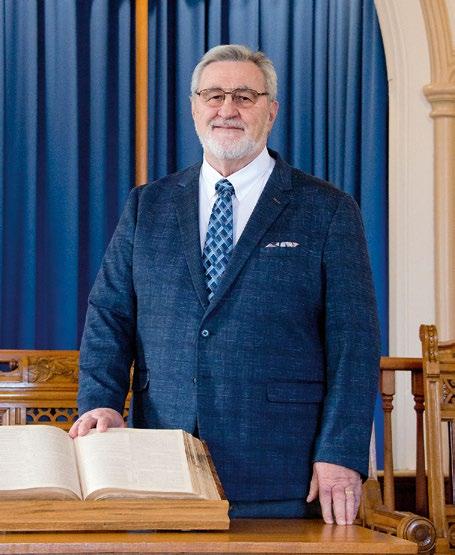
family ate was either hunted or homegrown. The family had no electricity and Fred was 13 before he saw his first toilet. In 2022, Fred published Skipper Ches: As Tough as It Gets, a memoir recounting his parents’ hardscrabble and courageous life in the fishing outport.
“My dream was to become a pilot, but instead I was recruited to teach physics and math straight out of university,” he says. “I quickly switched to the banking industry, married, and worked my way up the ranks, moving from Newfoundland to Ontario as the jobs demanded.” Eventually Fred became a manager at the Bank of Montreal in Toronto.
with a soundtrack of the music you grooved to through the years. With a bit of prompting the kids could ask about the accomplishments you are most proud of, the people and events that most influenced you, and what you hope to leave behind.
Great. This could check the “entertainment” box at a special birthday celebration.
But there is more to it than that. It’s easy to lose a sense of purpose as we age, so putting together a life review isn’t just about looking in the rearview mirror. It can also be the basis for looking forward to the next chapter of your life. Recalling memories of happy times or of surviving adversity – better still, writing them down and sharing them – is a way to reinforce self-esteem, optimism and a sense of meaning in life.
As Bernadette says, “While I do look for and focus on significant moments along each path, I also want to know what the client has learned and what they want to pass along to the next generation.”
The exercise could even provide a way to keep you connected to your community – an important factor in emotional well-being and resilience – perhaps by bringing together a group of like-minded individuals interested in writing their own life reviews. I’m all in.


In his 30s, Fred served the 1,200-person congregation of a Brampton church, first as volunteer secretary-treasurer, then for seven years as a consulting business manager. With his wife, Judee, he moved to Orangeville in 1992, working first for a printer, then starting his own management consulting company, serving clients across North America. All the while keeping up the deep connection to his religion.
In 2015 Fred was invited to deliver a guest sermon at Belfountain Village Church, which then had a congregation of about eight. “God led us here for a reason,” he says. At a time of life when most people retire, Fred and Judee attended pastoral school on weekends. Now as joint pastors in Belfountain, where Judee also serves as music director, they have watched the congregation grow to its current 110 and counting. Between them, Fred and Judee have seven children, 14 grandchildren and seven great-grandchildren. 905-880-7003










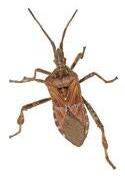





To build their one-of-a-kind Erin home, John and Cheryl Leenders leaned on the work of a Netherlands-based architect, their passion for both industrial and handcrafted elements, and their own hard work.
BY JANICE QUIRT • PHOTOGRAPHY BY ERIN FITZGIBBON

SET AGAINST A PICTURESQUE rural Erin backdrop, a formidable structure, all straight edges, metal and wood defies easy categorization. Is it a very stylish barn or industrial space? A sleek modern home? An ode to a fierce artistic vision? For owners John and Cheryl Leenders, the answer is yes – to all these questions.
A striking rusted Corten steel roof extends down the east and west sides of some of the oblong building – in sharp contrast to the unfinished look of the weathered grey hemlock that clads the remaining exterior walls.
More surprising, a large section of that exterior slides open to reveal a breezeway through the centre of the building. An open-air living and dining area during good weather, this space can be enclosed when temperatures drop. To the east of the breezeway is the main home with a kitchen and living area, bedroom suite, and den. A catwalk high above the breezeway links the upper floor to a loft, currently used as a workout room, on the west side of the breezeway.
The vision for the home came largely from John, who worked on
much of the build himself, with the help of Cheryl and subcontractors. In addition to being a secondgeneration chicken farmer, John is also a designer and maker of rusticyet-industrial tables created by combining wood pieces with cast-iron legs poured at Tiffany Metal Casting, a local foundry. And then there are the lights made from chicken feeders turned upside down.
“If I’m inspired to create it, I’ll build it myself,” he says. An example of this creativity is a one-of-a-kind table John made about 10 years
ago from a Goodyear sign. It was snapped up by Canadian business magnate and TV personality Arlene Dickinson. “She loved that it says Product of Canada on it.”
Some materials for the house project were custom aged before being installed. The exterior hemlock came from a Mennonite supplier, who wire brushed the boards to expose the grain, and then left them to bleach in the sun for 18 months. John prizes the look, as well as the sleek installation, which reverses the common board-and-batten method.

Here, the boards are laid on top of the battens. The carport on the west side of the building is lined with larch that was charred using the Japanese shou sugi ban method.
Other elements were chosen for their propensity to age well. The Corten roof and siding, for example, is designed to weather the elements without needing to be painted or treated. John says its rusty hue will change colour over time, developing a more purple hue, he says. In addition to feeling a deep affinity for the materials themselves, John now realizes the final look draws from
a niche architectural trend: Dutch farmhouse. A pair of the Leenders’ friends from the Netherlands were the first to pinpoint this design aesthetic, equal parts rugged and refined, after viewing images John posted on social media. When John’s parents were children, both their families emigrated from the Netherlands, and John and Cheryl have numerous family and friends there. So it’s no wonder Dutch farmhouse was a common, if subconscious, theme in John’s inspiration boards for the build. He notes the long, narrow shape is similar
to traditional farm dwellings in the Netherlands, where the living quarters are often at one end and the cattle and animals at the other.
A more intentional design influence was American architect Tom Kundig, known for rugged Pacific Northwest buildings that work with nature, not against it. But in late 2014 John and Cheryl tapped a Dutch architect for help. They visited Eindhovenbased Frank Goorts, owner of FG Architectuur. “Frank took the time to review my Kundig-heavy Pinterest boards to see the types of houses and
design we liked,” says John. “Cheryl and I went skiing in Austria for a few days, and when we came back he had the concept sketch ready – and it was perfect.” He adds that it was important to have a simple structure with a single roofline, but “I needed help to get the proportions correct.”
The house took about two years to build, from 2015 to 2017. Nicolas Auger of NA Structures in Quebec provided the pre-built and insulated wall panels, and installed the basic structure. The floors are ground and polished poured concrete, a finish



John refers to as “funky patina.” He deliberately chose unpolished steel for the interior doors to mimic the look of well-used shop doors with their accumulated fingerprints and other marks. The ceilings are reclaimed barn board, punctuated in many places by steel I-bars left in primer red.
The unheated breezeway is the couple’s favourite room, especially when hosting family gatherings
with their adult daughters, Morgan and Shelby. The space is perfectly comfortable in spring, summer and fall, featuring cozy leather seating and a spacious dining area under a set of retractable lights. The lights can be raised by a pulley above the catwalk to, say, create a dance floor, as the couple did for Morgan’s summer wedding to Chad Bryant.
John says the wedding was the deadline he needed to finish a few jobs, including the concrete pad out front,
which served as the seating area. (The family catered the event themselves, with help from local bakery Holtom’s, which provided a tower of fresh-fromthe-oven doughnuts.) He also installed the cool “aGoGo” lightbulb sign in red on a breezeway wall – another dance floor must-have. The family is unsure of the provenance of the sign, but hope it came from the famed Los Angeles rock club Whisky a Go Go, not the Concord, Ontario club of an … um … different nature.
Behind the house is a fully equipped outdoor kitchen nestled into walls made of reclaimed local barn foundation stone – “I’ve been collecting them for 20 years,” says John – and a long deck lined with red Muskoka chairs.
Indoors is a treasure trove of more reclaimed and repurposed antiques, and salvaged items. One of the cornerstones of the interior fireplace bears the stamp of the year 1891. John rescued it from the old Braden farm


around the corner on Erin’s 9th Line. The sink base in the powder room comes from an old dental cabinet, and the large stuffed ram standing sentinel at the top of the stairs to the secondfloor primary suite came from a local garage sale. “I saw it but left without buying. Two minutes later I was back,” says John. “I had errands to do in town afterwards, so I drove around with the ram in the back of the truck. I got a few funny looks that day.”
After all the wedding fun, it was
FAR LEFT: At the centre of the Leenders’ house is a spacious breezeway that serves as a three-season dining and living area.
TOP: The breezeway opens to the outdoors in the warmer months.
ABOVE LEFT: John and Cheryl enjoy a coffee in the outdoor kitchen area.









time for John to finish a few last details, including Cheryl’s favourite luxury in the house: a handcrafted deep tub made from stainless steel and wrapped in quartz that looks like white marble. “It’s actually so comfortable,” Cheryl says of the otherwise spaceship-esque soaker.
John says everything in the house was designed with functionality in
mind. When the family disperses, the couple closes off the breezeway to reduce upkeep. On the main floor that leaves them with John’s collectiblecrammed office, the powder room, a cozy living area and a low-key kitchen – covering about 1,300 square feet. Very few items in the house have been purchased from a store, save for the basic IKEA kitchen cabinets. Reclaimed A&W stools – in bright Dutch orange – meet an island built
on an iron base made in Alton in the 1800s. (John has been researching the name inscribed on it, “A. Dick,” and would love to hear from readers who may have leads for him.) “I like to take an antique and add on, seeing how I can put my personal touch on it,” he says.
Continuous improvement and unrelenting creativity are hallmarks of the couple’s approach to putting the final touches on this unique project.



TOP LEFT: The kitchen features an eclectic mix of salvaged industrial metal pieces, wood and hits of Dutch orange.


“Honestly, if I felt I was finished with the house, I might have to sell it,” John says. “And we rather hope this is our last house. But it’s more that the house is constantly evolving, and provides the opportunity to respond and design new solutions. That’s perfect for a creative maker like me.”
TOP RIGHT: John installed the vintage “aGogo” sign just in time for daughter Morgan’s wedding, when the breezeway served as dance floor.
LEFT: A handcrafted stainlesssteel bathtub stars in the couple’s ensuite.
RIGHT: A cozy den area off the kitchen features a fireplace built from local stone John has been collecting for decades.







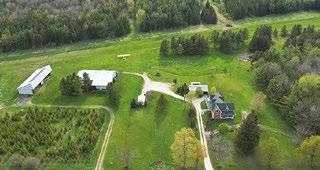









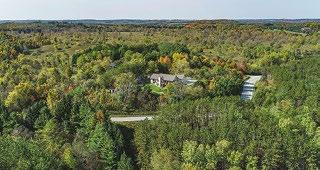








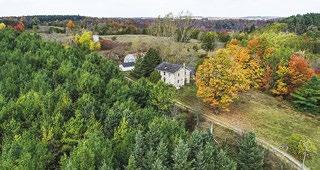













Dilbey win24_Layout 1 24-11-07 9:01 AM Page














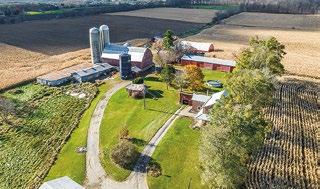
1




1


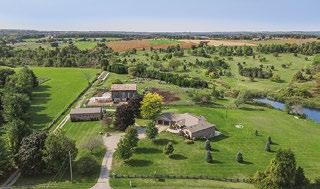


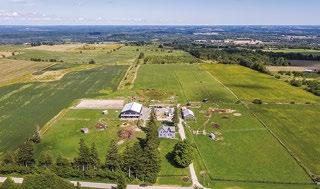

3




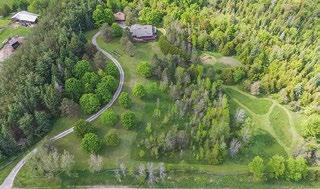

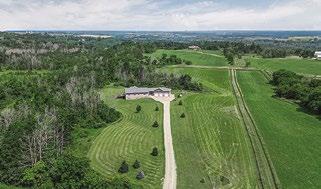























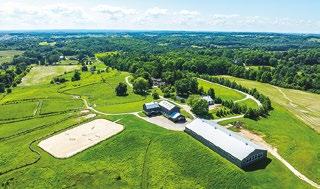
















Pia’s
Rustik Local Bistro 71 Spirit Tree Estate Cidery
The Busholme
BMO Nesbitt Burns Wealth Management, N. Meek
RBC Dominion Securities, S. Roud
45 Kennedy’s Flags
28 Orangeville Flowers
Suzanne Gardner Flowers
Village Green Florist FOOD, DRINK & CATERING
Erin Hill Acres
Amorettos
Gallery Gemma
Gallery Gemma
Hannah’s
Hides in Hand
More Than Just Baskets






















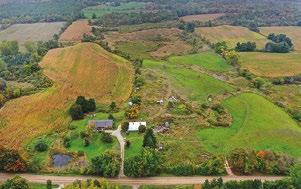














$5,199,000


floors
ceilings and tons of natural light!
bdrms on
floor Bright & airy finished lower level walkout to a manicured backyard Located on dead end st, steps to lake & trails!

$2,149,000 Wayne Baguley 519-941-5151 E M B R A C E S U S T A I N A B L E L I V
39-acre property has a charming 1-bdrm, 2-bath open-concept bungalow 4 outbuildings, cozy yurt, 3 hoop houses & 2 ponds
Enjoy the freedom to grow your own food
$1,999,000 Wayne Baguley 519-941-5151


Orton park, and winter skating rink $939,000 Wayne Baguley 519-941-5151 L
Two 1800s log cabins sculpted together on 56 acs Wood beam







COMPILED BY JANET KERR • ILLUSTRATIONS BY JIM STEWART
NOW – JAN 5 : ARTFUL GIVING: HOLIDAY GIFT & FINE ART SALE
Unique handmade items in various media. Wed-Sun 10am-5pm. Free. Alton Mill Arts Centre, 1402 Queen St, Alton. Headwaters Arts Gallery, 519-943-1149; headwatersarts.org
NOW – JAN 18 : ANIMA(LIS) Artwork about transformation by Orangeville artist Stephanie Casino Esguerra. Tue-Sat. Museum of Dufferin, Airport Rd & Hwy 89, Mulmur. 1-877941-7787; dufferinmuseum.com
NOW – MAR 16 : UNVEILING ABILITY: EMPOWERMENT THROUGH ART
An inspiring collection of quilts, wallhangings and paintings created by the artists of Brampton Caledon Community Living. PAMA, 9 Wellington St E, Brampton. 905-791-4055; pama.peelregion.ca
NOW – MAR 30 : APPLE A DAY
Brampton-based artist Meegan Lim examines food insecurity in today’s economic reality on PAMA’s outdoor banners. Brampton Arts Organization, PAMA, 9 Wellington St E, Brampton. 905-791-4055; pama.peelregion.ca
NOW – MAR 31 : YOUTH ON RECONCILIATION Thoughts on Canada’s future through the lens of hope and respect. Legacy of Hope Foundation,
Department of Canadian Heritage, PAMA, 9 Wellington St E, Brampton. 905-791-4055; pama.peelregion.ca
NOV 22 – 24 : GRAND VALLEY LIBRARY
USED BOOK SALE Great selection of used fiction, nonfiction, DVDs and children’s books. Fri Sat 10am. Sun noon. Fill a bag with books for $6. 4 Amaranth St E, Grand Valley. grandvalley.org
NOV 22 – DEC 1 : ON A GRAND
SCALE Art exhibition of large-scale oil paintings by Janet Simmons Sweet. Wed-Sun 10am-5pm. Free. 1402 Queen St, Alton. 519-941-9300; altonmill.ca
NOV 23 : SILENT AUCTION & BOOK SALE Find the perfect treasure. Item donations accepted. 10am-4pm. Shelburne Library, 201 Owen Sound St, Shelburne. 519925-2168; shelburnelibrary.ca
NOV 23 & 24 : ALTON MILL HOLIDAY
OPEN HOUSE Open artist studios, Christmas market, live music and more! 10am. Free. 1402 Queen St, Alton. 519-941-9300; altonmill.ca
NOV 23 – MAR 23 : DAVID BLACKWOOD: ODE TO NEWFOUNDLAND Moody intaglio prints and watercolour landscape paintings of the artist’s beloved province. PAMA, 9 Wellington St E, Brampton. 905-791-4055; pama.peelregion.ca
NOV 23 – APR 6 : IN LOVE & IN ART: JIM REID, GINA RORAI, PEGGY TAYLOR REID & DAVID URBAN
Works by two contemporary artist couples focus on moments in the artists’ creative development. PAMA, 9 Wellington St E, Brampton. 905791-4055; pama.peelregion.ca
NOV 26 – ONGOING (TUESDAYS) : GET CRAFTY CLUB Bring your crochet, knitting, sketching or any project you’re working on! 1-3:30pm. Shelburne Library, 201 Owen Sound St, Shelburne. 519-925-2168; shelburnelibrary.ca
NOV 27 – DEC 8 : HOLIDAY TREASURES CRAFT MARKET Over 68 vendors, makers and craftspeople. Workshops available. Wed-Sun 10am4pm. Museum of Dufferin, Airport Rd & Hwy 89, Mulmur. In The Hills, MoD, 1-877-941-7787; dufferinmuseum.com
NOV 28 : HEART & SOUL –POETRY PERFORMANCE Join Mississauga Poet Laureate Andrea
Josic and guests. 7-8:30pm. PAMA, 9 Wellington St E, Brampton. 905791-4055; pama.peelregion.ca
NOV 28, DEC 5, 12 & 19 : ONLINE PAINTING STUDIO WITH ANDREW CHEDDIE SOOKRAH Live Zoom instruction for all levels. 3-6pm. $270–$324. 10365 Islington Ave, Vaughan. mcmichael.com
NOV 28 & DEC 6 : GARLAND-MAKING WORKSHOP Craft the perfect vintageinspired garland. Includes admission to Holiday Treasures Craft Market. 11am-noon. $25. Museum of Dufferin, Airport Rd & Hwy 89, Mulmur. 1-877941-7787; dufferinmuseum.com
NOV 29 : SOAP-MAKING WORKSHOP Create the perfect set of customized soap bars. Includes admission to Holiday Treasures Craft Market. 11:30am-1pm. $50. Museum of Dufferin, Airport Rd & Hwy 89, Mulmur. 1-877941-7787; dufferinmuseum.com
NOV 29 & 30 : THE VERY MERRY MARKET Curated selection of local handmade goods, treats and unique gifts. Decorate festive cookies and snap photo booth memories. Fri 4-8pm. Sat 11am5pm. Free. 305 Col. Phillips Dr, Shelburne. 289-203-8202; streamshub.org

NOV 29, 30 & DEC 1 : MCMICHAEL VOLUNTEER COMMITTEE AUTUMN ART SALE FUNDRAISER Original art and sculpture by 50 contemporary Canadian artists. Proceeds to artists and projects. Fri: 6-10pm, opening gala. Sat Sun 10am-5pm. 10365 Islington Ave, Kleinberg. mcmichael.com
NOV 30 : HEARTSTRINGS DROPIN ACTIVITY WITH CALEDON PRIDE Contribute to our interactive textile mural. 11am-4pm. PAMA, 9 Wellington St E, Brampton. 905791-4055; pama.peelregion.ca
DEC 1 : CHRISTMAS IN THE VALLEY ARTS & CRAFTS SHOW Over 40 vendors selling various items. 9am-3pm. Free, donations to Grand Valley Food Bank appreciated. Grand Valley Public School, 120 Main St N, Grand Valley. 519-943-5471; grandvalleylions.com
DEC 5 : CROCHET STOCKING WORKSHOP Crochet a mini masterpiece. Includes admission to the Holiday Treasures Craft Market. 11am12:30pm. $25. Museum of Dufferin, Airport Rd & Hwy 89, Mulmur. 1-877941-7787; dufferinmuseum.com
DEC 5 : CONNECTIONS ART & BOOK
CLUB Enjoy a discussion of Donna Morrissey’s Rage in the Night paired with the David Blackwood exhibit. 7-8:30pm. Free, register with Brampton Library. PAMA, 9 Wellington St E, Brampton. 905-791-4055; pama.peelregion.ca
DEC 8 : ADULT ART LESSON AT ALBION HILLS FIELD CENTRE Transform old clothes into vibrant, wearable art. Or enjoy an indoor painting class. No experience necessary, materials provided. 1pm. $60, register. 16555 Humber Station Rd, Caledon. 416-568-3297: trca.ca
DEC 8 : WREATH-MAKING WORKSHOP Create a 10-inch wreath with local foliage and other festive materials. Includes admission to Holiday Treasures Craft Market. 11am-noon. $35. Museum of Dufferin, Airport Rd & Hwy 89, Mulmur. 1-877-941-7787; dufferinmuseum.com
JAN 8 – FEB 9 : DREAMSCAPE
Astounding exhibit of 30-plus works by 25 talented artists. Wed-Sun 10am-5pm. Free. Alton Mill Arts Centre, 1402 Queen St, Alton. Headwaters Arts Gallery, 519-943-1149; headwatersarts.org
FEB 9 : CHINESE PAPER-CUTTING WORKSHOP Discover the cultural heritage of this traditional art with Kris
Yun Xie. 1:303:30pm. PAMA, 9 Wellington St E, Brampton. 905-791-4055; pama.peelregion.ca
FEB 12 – MAR 16 : COLOUR Artworks by 30-plus artists explore colour in various media. Wed-Sun 10am-5pm. Free. Alton Mill Arts Centre, 1402 Queen St, Alton. Headwaters Arts Gallery, 519-943-1149; headwatersarts.org
MAR 1 : BATIK HOOP ART WITH DEON BEST Create colourful art for your home. 11am-2pm. $15. PAMA, 9 Wellington St E, Brampton. 905791-4055; pama.peelregion.ca
SANTA CLAUS PARADES & EVENTS
NOV 30 : ERIN Parade. 11am12:30pm. McCullough Dr south end to firehall.erin.ca
NOV 30 : GRAND VALLEY Free skate and parade. Parade 7pm. 3-8pm. facebook.com
DEC 7 : SHELBURNE Parade. 6pm. shelburnebia.ca
DEC 7 : CALEDON VILLAGE Parade, then tree lighting and activities. 4:30-8pm. Hwy 10 and Charleston Sdrd. caledonvillage.org
DEC 7 : CREEMORE Parade. 1:30pm. Mill St. creemore.com
DEC 7 : BOLTON Parade. 11am. Hwy 50. boltonkin.com
DEC 7 : PALGRAVE Tree lighting. 5:307:30pm. Stationlands Park, 45 Brawton Dr and Hwy 50. facebook.com
NOW – DEC 24 : THE SISTERS TOUCH OF CHRISTMAS An exclusive fundraising store featuring one-of-a-kind, handpainted, personalized ornaments, bakery and Christmas decor. Thur, Fri 10am-7pm. Sat 10am-6pm. Sun 11am4pm. Dec 24 10am-3pm. St. Kosmas Aitolos Greek Orthodox Monastery, 14155 Caledon-King Town Ln S, Bolton. 905-859-8077; thesisterstoc.com
NOW – APR 19 (SATURDAYS) : ORANGEVILLE WINTER FARMERS’ MARKET Locally grown produce, meats, small-batch sweets and savouries, handcrafted goods and more! 9am-1pm. Orangeville Town Hall, 87 Broadway. Orangeville BIA, 519942-0087; downtownorangeville.ca
NOW – ONGOING : SENIORS’ WELLNESS PROGRAM – AGES 55+ Chair/ standing exercise, snacks, games and guest speakers. Mono Mills: Mon 11am12:30pm. Victoria Parks Community Centre, 35 Victoria Cres. Valleywood: Tue 10am-noon. Caledon Library, 20 Snelcrest Dr. Cheltenham: Wed 10amnoon. Cheltenham Baptist Church, 14520 Creditview Rd. Palgrave: Fri 9:30-11:30am. Palgrave United Church, 34 Pine Ave. Free. Caledon Meals on Wheels, 905-857-7651; cmow.org
NOW – ONGOING (SECOND TUESDAY) : EUCHRE CARDS & LUNCHEON
Delicious lunch and two hours of fun and mildly competitive euchre. Noon-3pm. $10. Caledon Library, 20 Snelcrest Dr, Caledon. Caledon Meals on Wheels, 905857-7651; cmow.org
NOV 22 : OPERATION CHRISTMAS CHILD Giftfilled shoeboxes are sent around the world to show children God’s love. Drop off noon-3pm. Boxes also filled online. Broadway Pentecostal Church, 556 Broadway, Orangeville. 416697-9999; samaritanspurse.ca
NOV 22 & 23 : BETHELL HOSPICE HOLIDAY BAZAAR
Homemade goods, greenery, jewelry and gently used items. All proceeds to Bethell Hospice Foundation. 9am-1:30pm. Inglewood Community Centre. 905-8383534; foundations.bethellhospice.org
NOV 22 & FEB 28 : CALEDON SENIORS’ CENTRE MONTHLY DINNERS Nov 22: shepherd’s pie. Feb 28: stuffed chicken. All welcome. Pickup 5:15pm, dine-in 5:30pm. $16; local delivery $2; call two days prior by 3:30pm to register. 5:15-7pm. 7 Rotarian Way, Bolton. 905-951-6114; caledonseniors.ca
NOV 23 : CALEDON EAST CHRISTMAS MARKET & BAKE SALE Many vendors with beautiful handcrafted items. Take a Chance and raffle gift baskets. 9am-3pm. Caledon East United Church, 6046 Old Church Rd.
NOV 23 : ST. ANDREW’S HILLSBURGH CHRISTMAS MARKETPLACE & BAKE SALE Local vendors selling wreaths, jewelry, cards, embroidered items, Avon, Epicure and more! 10am-1pm. 83 Trafalgar Rd, Hillsburgh. 519-855-6216; pccweb.ca
NOV 23 : DUFFERIN CHRISTMAS MARKET Handmade with love. See 150 unique artisans, family activities, food trucks, cafe and live entertainment. 10am-4pm. Orangeville Agriculture Centre, 247090 5 Sdrd Mono. dufferinevents.ca
NOV 23 : PROCYON WILDLIFE FUNDRAISING GALA Hors d’oeuvres, auctions, four-course dinner, music by Mars Giammarco and Echo. $200/pp. 5:30-11:30pm. Caesar’s Banquet Centre, 8841 George Bolton Pkwy, Bolton. 905729-0033; procyonwildlife.com
NOV 24 : PAMA NEW EXHIBITIONS OPEN HOUSE Artists, partners and collaborators will be present to share insights. 1-5pm. Free. PAMA, 9 Wellington St E, Brampton. 905791-4055; pama.peelregion.ca
NOV 29 : HOME FOR THE HOLIDAYS GALA | STORIES UNMASKED A beautiful and entertaining evening in support of Caledon neighbours in need. 6pm. $195. The Royal Ambassador Event Centre, 15430 Innis Lake Rd, Caledon East. CCS, 905-584-2300 x230; ccshome4theholidays.com
NOV 30 : WESTMINSTER ADVENT FAIR Bazaar, bake sale, café, nativity displays and the popular penny auction. 9am-2pm. 247 Broadway, Orangeville. 519-941-0381; westminsterorangeville.ca
NOV 30 : CREEMORE’S CHRISTMAS IN THE VALLEY Christmas farmers’ and maker market, carollers and free horse-drawn wagon rides. 9am-3pm. Mill St, Downtown Creemore. Creemore BIA, 416-315-7255; experiencecreemore.com
NOV 30 & FEB 15 : CALEDON SENIORS’ CENTRE LUNCHES & BID EUCHRE TOURNAMENTS Nov 30: sausage on a bun. Feb 15: spaghetti Bolognese. Check-in 11:30am, lunch noon, tournament 1pm. Prizes and more! Lunch $16; tournament $15; tournament and lunch $20, call two days prior to register. 11:30am-4:30pm. 7 Rotarian Way, Bolton. 905-951-6114; caledonseniors.ca

DEC 1 – 31 : CHRISTMAS IN THE PARK Walk through a festival of lights, displays, music and entertainment. Dog-friendly. Dec 1: opening ceremony, 6:30pm. 5:30-10pm. Free. Kay Cee Gardens, 29 Bythia St, Orangeville. Optimist Club of Orangeville, orangevilleoptimists.ca
DEC 5 : BETHELL HOSPICE CELEBRATE LIGHT & LOVE TREE
LIGHTING A tranquil time to honour a loved one. Donate online or call the fundraising office. 7-9pm. Inglewood Community Centre. 905-838-3534; bethellhospicelightandlove.ca
DEC 5, JAN 9, FEB 13 & MAR 13 : ORANGEVILLE & DISTRICT PROBUS
MEETINGS A club for socially engaged people, retired or semiretired. Guests welcome. Dec 5: Leisa Way – singer and entertainer. Jan 9: Sean Chercover – award-winning Canadian writer. Feb 13: Annemarie Hagen – historian. Mar 13: Vikki Pappas – The Longrun Thoroughbred Retirement Society. 10am-noon. Free. New Hope Community Church, 690 Riddell Rd, Orangeville. 519-938-8934; probusorangeville.club
DEC 6 : CALEDON SENIORS’ CENTRE
CHRISTMAS DINNER & DANCE Turkey and all the fixings. All welcome. Dine-in only 6:30pm. Entertainment and dancing to follow dinner. $40, call to register. 6:30-10:30pm. 7 Rotarian Way, Bolton. 905-951-6114; caledonseniors.ca
DEC 7 : KNOX CHRISTMAS MARKET & BAKE SALE Early Christmas shopping with our 15 fantastic vendors! Wheelchair accessible. 9am2pm. Free. Knox United Church, 2976 Charleston Sdrd, Caledon Village. 519-927-3320; knox-united-church.org
DEC 7 : FAMILY HOLIDAY GIVING DAY AT THE EXCHANGE Guided tour, sort food donations, help in the kitchen. Nonperishable food items accepted. 10am-4pm. The Exchange, 55 Healey Rd, Unit #10, Bolton. CCS, 905-584-2300 x230; ccs4u.org
DEC 7 : CHRISTMAS AT THE RANCH Western fun, Santa Skate, pony and hay rides, outdoor campfire and more! Christmas trees and evergreen bundles for sale. 11:30am-3pm. 20682 Hurontario St, Caledon. 519-941-4501; teenranch.com
DEC 7 : LAVENDER LOUNGE + BOUTIQUE SIP + SHOP Local vendors, live music, complimentary charcuterie and wine. $5 coupon.
Proceeds support Family Transition Place. Noon-5pm. $10. Hereward Farm, 141051 15 Sdrd, East Garafraxa. 226-779-4973; herewardfarm.com
DEC 7, 14 & 21 : CREEMORE CHRISTMAS MARKETS Indoor markets with the Creemore Farmers and Craft Market. See 22 vendors each day. 9am-1pm. Free. Station on the Green, 10 Caroline St E, Creemore. creemorefarmersmarket.ca
DEC 19 : CALEDON SENIORS’ CENTRE CHRISTMAS LUNCHEON The menu is roast beef and all the trimmings. All welcome. Dine-in only 12:30pm. Entertainment follows lunch. $40, call to register. Noon-3:30pm. 7 Rotarian Way, Bolton. 905-951-6114; caledonseniors.ca
DEC 27 : BOLTON ROTARY FAMILY
SKATE Enjoy music and snacks. 10am-11:20am. Free. Albion Bolton Community Centre, Bolton. Rotary Club of Bolton, boltonrotary.ca
JAN 11 : CALEDON SENIORS’
CENTRE BRIDGE & OH HELL
TOURNAMENTS & LUNCH Lasagne and all the fixings. Check-in 11:30am, lunch noon, tournaments 1pm. Prizes and more. Lunch $16; tournament $15; both $20, call by Jan 9 to register. 11:30am-4:30pm. 7 Rotarian Way, Bolton. 905-951-6114; caledonseniors.ca
JAN 14, FEB 11 & MAR 11 : ORANGEVILLE & DISTRICT HORTICULTURAL SOCIETY MEETINGS Jan 14: Beekeeping and All About Bees. Feb 11: Landscaping Using Naturalistic Principles. Mar 11: Sustainable Gardening. Guests welcome, prizes, bring mug for refreshments. 6:30-8:30pm. Orangeville & District Senior Centre, 26 Bythia St, Orangeville. orangevillehort.com
JAN 15 & FEB 12 : CALEDON SENIORS’ CENTRE SPECIAL LUNCHES Jan 15: turkey pot pie. Feb 12: chili. All welcome. Pick-up 11:30am, dine-in noon. $11; local delivery $2, call two days prior at noon to register. 11:30am-1pm. 7 Rotarian Way, Bolton. 905-951-6114; caledonseniors.ca
JAN 18 : SHELBURNE HEALTH & WELLNESS EXPO Registered practitioners, alternative healers, fitness professionals, wellness products and more. 10am-3pm. Free. Centre Dufferin District High School, 150 4th Ave, Shelburne. theshwe.com
JAN 21, FEB 11 & MAR 11 : CALEDON SENIORS’ CENTRE MEN’S LUNCHES
Jan 21: fish and chips. Feb 11: chicken Caesar wraps. Mar 11: meatball subs. $11, call to register. 11am-1pm. 7 Rotarian Way, Bolton. 905-951-6114; caledonseniors.ca
JAN 24 : CALEDON SENIORS’ CENTRE
ROBBIE BURNS DINNER Roast beef, haggis and all the trimmings. All welcome. Pick-up 5:15pm, dine-in 5:30pm. Live entertainment. $40; local delivery $2; call by Jan 22 at 3:30pm to register. 5:15-8pm. 7 Rotarian Way, Bolton. 905-951-6114; caledonseniors.ca
JAN 25 : ROBBIE BURNS CONCERT, SCOTTISH TEA & SILENT AUCTION Celtic music, sticky toffee pudding, shortbreads and more! 2-4:30pm. $20. St. Andrew’s Presbyterian Church Hillsburgh, 519-855-6216
JAN 25 & 26 : FIRE & ICE 2025 Ice carving, children’s activities, vendor market, fire sculpture, delicious food and drink, and an exclusive ticketed live performance. Sat noon-6pm. Sun noon-5pm. 1402 Queen St, Alton. 519-941-9300; altonmill.ca
MAR 7 : INTERNATIONAL WOMEN’S DAY WITH TRACY MOORE Join us as we welcome this celebrated and energetic speaker. All proceeds to Family Transition Place. Early bird tickets Dec 1-Feb 2. Presented by GoYoga. Hockley Valley Resort, 793522 3rd Ln Mono. Family Transition Place, 519-9424122 x243; familytransitionplace.ca
MAR 15 : CALEDON SENIORS’ CENTRE ST. PATRICK’S DAY LUNCH & EUCHRE TOURNAMENT Corned beef and all the trimmings. Check-in 11:30am, lunch noon, tournament 1pm. Prizes and more!
Lunch $16; tournament $15; tournament and lunch $20, call by Mar 13 to register. 11:15am-4:30pm. 7 Rotarian Way, Bolton. 905-951-6114; caledonseniors.ca
NOV 22-24, 29-30, DEC 1, 6-8 : A SNOW WHITE CHRISTMAS – AGES 8+ A musical fairytale for the whole family. Did Prince Charming and Snow White live happily ever after? Some adult humour and themes, no offensive language. Wed Fri Sat 8:15pm. Sun 2:15pm. Please bring food drive donation. 17272 Blackhorse Village Players, Mt Wolfe Rd & Hwy 9, Caledon. 905880-5002; blackhorsetheatre.ca
NOV 23 : SANTA PHOTO DAY Snacks at Caledon Village Place for donations to the Agricultural Society. Proceeds to the community centre. 10am-3pm. $2–$4. Caledon Village Place, 18313 Hurontario St. Caledon Village Association, 519-927-3557; caledonvillage.org
NOV 23, 24 & 30 : NOVEMBER DIY STUDIO TIME – AGES 5+ Drop in and make a railway-inspired craft. All children with an adult. 1-4:30pm. PAMA, 9 Wellington St E, Brampton. 905-791-4055; pama.peelregion.ca
NOV 23, 24 & 30, DEC 1, 6-8 : CINDERELLA – PANTOMIME – AGES 5+ Boo the baddies, cheer the heroes and heroines, and sing along. No infants please. Fri 7:30pm. Sat Sun 2pm. Nov 30: 2 & 7:30pm. $15. 72 Trafalgar Rd, Hillsburgh. 519-855-4586; centurychurchtheatre.com
NOV 28 – 30, DEC 1, 4-8, 11-15, 18-21 : SLEEPING BEAUTY ... A FAIRY’S TALE Boo the villain and cheer for the hero! You’ll laugh till your face hurts! Sun Wed 2pm. Thu-Sat 7:30pm. Dec 12: 11am & 7:30pm. Dec 18: 7:30pm. Dec 21: 2 & 7:30pm. Theatre Orangeville, 87 Broadway, Orangeville. 519-942-3423; theatreorangeville.ca
NOV 30 : FAMILY STAINED GLASSPAINTING WORKSHOP Make the perfect vintage-inspired stained glass frame. Ticket includes admission to Holiday Treasures Craft Market. $15 per family. 11am-noon. Museum of Dufferin, Airport Rd & Hwy 89, Mulmur. 1-877-941-7787; dufferinmuseum.com



NOV 30 : SALT DOUGH ORNAMENTS
WORKSHOP Each child makes at least three ornaments. 2-3pm. $15. Museum of Dufferin, Airport Rd & Hwy 89, Mulmur. 1-877-941-7787; dufferinmuseum.com
DEC 6-8 : OLIVER! JR Young Oliver discovers the true love of family. You’ll sing along to “Consider Yourself,” “Food Glorious Food” and “Oom-Pah-Pah.” Fri Sat 7:30pm. Sun 2pm. $18. Grace Tipling Hall, 203 Main St E, Shelburne. 519-9399038; lpstageproductionsinc.com
DEC 7 : CHILDREN’S CHRISTMAS CRACKER WORKSHOP Each child gets two crackers to make. 2:303:30pm. $15. Museum of Dufferin, Airport Rd & Hwy 89, Mulmur. 1-877941-7787; dufferinmuseum.com
DEC 18 : MOD-TOTS: WINTER WONDERLAND – AGES 1 TO 4 Tot-friendly winter-themed crafts and sensory play. All children with an adult. $7, register. 9am-noon. Airport Rd & Hwy 89, Mulmur, 1-877-941-7787; dufferinmuseum.com
DEC 27 – JAN 3: WINTER BREAK AT PAMA 10:30am-4pm each day. PAMA, 9 Wellington St E, Brampton. 905-791-4055; pama.peelregion.ca
Dec 27: APPLE A DAY WITH MEEGAN LIM Create an apple craft inspired by Meegan’s banners.
DEC 28 : A DAY OF FOLK TALES & MUSIC Enjoy professional teller Laxmi Balaji, the Brampton Folk Club and create your own jigsaw puzzle.
DEC 30 : TOASTY TEXTILES Make yarn art inspired by the warm knitwear of Newfoundland.
JAN 2 : FAKE FOOD Take part in fakefood making inspired by our favourite comfort foods.
JAN 3 : WINTERY WATERCOLOUR Design a frosty card with watercolour and salt.
JAN 4 – 26 (SATURDAYS & SUNDAYS) :
DIY STUDIO TIME – AGES 5+ Make your own miniature museum collage. All children with an adult. 1-4:30pm. PAMA, 9 Wellington St E, Brampton. 905-791-4055; pama.peelregion.ca
FEB 1 – 23 (SATURDAYS & SUNDAYS) :
DIY STUDIO TIME – AGES 5+ Make your own paper puppet and create their story. All children with an adult. 1-4:30pm. PAMA, 9 Wellington St E, Brampton. 905-791-4055; pama.peelregion.ca
Submit your event
To submit your community, arts or nonprofit event:
Select “What’s On” from the menu bar at inthehills.ca.
That will take you to the listings page. Select “Add Your Community Event” and complete the easy form.
Submit by Friday, February 14, 2025 for the spring (March) issue.
For up-to-date listings between issues, go to inthehills.ca/events.
We reserve the right to edit submissions for print and web. inthehills.ca
FEB 11 : THE GRUFFALO’S CHILD BY TALL STORIES – AGES 3+ Let your imagination run wild with songs, laughs and scary fun for the whole family. 6-8pm. The Rose Theatre, 1 Theatre Ln, Brampton. Brampton On Stage, 905-874-2800; tickets.brampton.ca
FEB 14 : CANADIAN MULTICULTURAL INVENTORS MUSEUM AT PAMA
This PA Day visit the popup exhibit International African Inventors. View The Road Taken – a documentary on Black sleeping-car porters in Canada.
PAMA, 9 Wellington St E, Brampton. 905-791-4055; pama.peelregion.ca
FEB 17 : FAMILY DAY AT PAMA
Create fluffy cloud creations, be wowed by Pastel’s Imaginarium or enjoy an interactive storytelling session. See website for schedule. PAMA, 9 Wellington St E, Brampton. 905-791-4055; pama.peelregion.ca
MAR 10 – 14 : MARCH BREAK AT PAMA Enjoy magicians, puppet shows, musical storytelling, plays, drumming sessions and hands-on, drop-in
workshops. See website for schedule. PAMA, 9 Wellington St E, Brampton. 905-791-4055; pama.peelregion.ca
MAR 11 : JIM HENSON’S FRAGGLE ROCK: BACK TO THE ROCK LIVE An unforgettable, life-sized theatre experience perfect for families and Fraggle Rock fans of all ages. 3 & 6:30pm. The Rose Theatre, 1 Theatre Ln, Brampton. Brampton On Stage, 905-874-2800; tickets.brampton.ca
NOV – MAR: LIVE MUSIC AT ROSE THEATRE All performances at 8pm unless noted. Rose Theatre, 1 Theatre Ln, Brampton. 905-874-2800; rosetheatre.ca
NOV 22 : GLASS TIGER From raucous rock anthems to ethereal pop, their music transcends generations.
NOV 23 : KIRK DIAMOND WITH AMMOYE Socially conscious anthems in a dynamic blend of reggae, soul and R&B.
DEC 7 : CHRISTMAS AT THE ROSE WITH BRAMPTON CONCERT BAND A joyful evening of merry melodies. 7:30pm
DEC 10 : B-JAZZED: A BIG BAND CHRISTMAS An evening of the greatest music of the 20th century and insightful conversation.
DEC 11 : THE CELTIC TENORS: A CELTIC CHRISTMAS Celebrating the spectacular sounds of Christmas.
DEC 13 : THE STRUMBELLAS: PARTTIME BELIEVER TOUR Experience the journey of this alt-folk powerhouse.
DEC 14 : CRATE CLASH The youngest and hottest DJs ages 12 to 19 battle for top spot. 7pm
DEC 14 : YULE SING The Rose Orchestra welcomes the Brampton Children’s Chorus and St. Roch Chorale. 7:30pm
DEC 21 : A NEXT GENERATION LEAHY CHRISTMAS These multi-instrumentalist siblings have delivered astounding performances across North America. 7pm
JAN 28 : B-JAZZED: BEPOPS, BALLADS & BLUES Soulful sounds and musical virtuosity of Canada’s best jazz musicians.
JAN 30 : STAGEDOOR STORIES: TWIN FLAMES Husband-and-wife duo blends powerful folk and rock ‘n’ roll.
FEB 1 : 54•40 For over 40 years this band has delivered electrifying live shows.
FEB 6 : HYPE From sensational singers to mesmerizing dancers.
FEB 8 : THE ROSE ORCHESTRA: TOO DARN HOT! Adi Braun and the timeless songs of musical legend Cole Porter. 7:30pm
FEB 14 : JULLY BLACK An evening with a visionary and Canadian icon.
FEB 15 : TORONTO SYMPHONY
ORCHESTRA: HOT! HOT! HOT! Enjoy the vibrant world of island music with Captain Daniel BartholomewPoyser and special guests. 2pm
FEB 21 : CHOIR! CHOIR! CHOIR! – WE WILL CHOIR! YOU: AN EPIC QUEEN SINGALONG The audience is the performance. All voices welcome, no experience necessary.
FEB 23 : BRAMPTON CONCERT BAND & THE JAZZ MECHANICS FEATURING LEE SIEGEL A blend of captivating melodies and powerful performances. 2pm
FEB 26 : BLUEBIRD BRAMPTON An acoustic showcase of Southern Ontario’s best country music talent. New venue: Cyril Clark Theatre, 20 Loafers Lake Ln, Brampton.
FEB 28 : FINGER 11 Their record-breaking run at rock radio and numerous awards cement their status as musical icons.
MAR 6 : MIMI O’BONSAWIN Uplifting melodies and introspective lyrics weave pop sensibilities with acoustic instruments. New venue: Cyril Clark Theatre, 20 Loafers Lake Ln, Brampton.
MAR 8 : BIF NAKED An unstoppable rock force embodying resilience, passion and unwavering commitment.
NOV 22 : NAOMI BRISTOW IN CONCERT Join us for an evening of music. 7-8:30pm. $20, call or email to register. 346255 15 Sdrd, Mono. 519-9410972; highcountryunited.weebly.com
NOV 30 & DEC 1 : ACHILL HOLIDAY CONCERTS A fun-filled afternoon of music. 4pm. $30; youth $15, at achill.ca, Westminster United Church Orangeville, BookLore, Forster’s Book Garden and Papermoon. Nov 30: Knox Presbyterian Church, 160 King St S, Alliston. Dec 1: Westminster United Church, 247 Broadway, Orangeville. Achill Choral Society, achill.ca









DEC 1 : CHATEAU WINDRUSH HOLIDAY CHEER Mezzo-soprano Hillary Tufford joins pianist Connor O’Kane on a concert tour of transformative art song. 3pm. $45, includes wine reception, treats and meeting the artists. Guests under 19 or 90+ free. Part proceeds to arts for underserved kids at youthLEADarts.com. Chateau Windrush, 3030 Con Rd 3 Adjala. 905729-0060; windrushestatewinery.com
DEC 1 : FANFARE & FLURRIES – A CHRISTMAS CONCERT Join Caledon Concert Band to celebrate Christmas with one of our favourite traditions. 2-4pm. $20. Caledon Hills Fellowship Baptist Church, 16595 Airport Rd, Caledon East. 905-951-7979; caledonconcertband.ca
DEC 6 : HALLELUJAH! HANDEL’S
MESSIAH The Great Lakes Philharmonic orchestra joins the Brampton Festival Singers. 7:30-9:30pm. $30, eventbrite. ca or at door (cash only). St. Paul’s United Church, 30 Main St S, Brampton. 905-846-0701; bfschoir.wix.com
DEC 7 : ORANGEVILLE COMMUNITY BAND CHRISTMAS CONCERT Traditional Christmas music and modern classics. 2-4pm. $20, online. New Hope Community Church, 690 Riddell Rd, Orangeville. orangevillecommunityband.ca

DEC 7 : CALEDON CHAMBER CONCERTS PRESENTS DOLINKAYALEH DUO An evening of music with world-class musicians. 7:309:30pm. $40; 16 & under free. St. James Anglican Church, 6025 Old Church Rd, Caledon East. 905-838-0888; caledonchamberconcerts.com
DEC 17 : HILLSBURGH SPARKLES –A COMMUNITY CAROLLING EVENT
Celebrate the season with the Young at Heart Singers. 6:15-7:15pm. Free. 9 Station St, Hillsburgh. 519-855-4010; wellington.ca
JAN 31 : THE LEGENDARY PATSY CLINE SHOW Amberley Beatty embodies the spirit and soul of this great singer. 7:30-9:30pm. $70. The Gibson Centre for Community, Arts and Culture, 63 Tupper St W, Alliston. 705-435-2828; gibsoncentre.com

FEB 9 : CHATEAU WINDRUSH –AMOR SPANISH LOVE SONGS Rubén Vázquez, piano, Liza McLellan, cello and Romulo Delgato, tenor. 3pm. $45, includes wine reception and meeting the artists. Guests under 19 or 90+ free.
Part proceeds to arts for underserved kids in the arts at youthLEADarts. com. 3030 Con Rd 3 Adjala. 905-7290060; windrushestatewinery.com
FEB 16 : CHATEAU WINDRUSH – ALL FOR LOVE Alexandra Teske, soprano and Lillian Brooks, mezzo-soprano. Back by popular request. 3pm. $45, includes wine reception, and meeting the artists. Guests under 19 or 90+ free. Part proceeds to arts for underserved kids at youthLEADarts. com. 3030 Con Rd 3 Adjala, 905-7290060; windrushestatewinery.com
FEB 28 : BRITISH LEGENDS An allCanadian cast performs perfectly, note for note. 7:30pm. $75. The Gibson Centre for Community, Arts and Culture, 63 Tupper St W, Alliston. 705-435-2828; gibsoncentre.com
MAR 1 : CALEDON CHAMBER CONCERTS – VENUTI STRING QUARTET Enjoy an evening of beautiful music. $40; 18 & under free. 7:30pm. St. James Anglican Church, Caledon East, 6025 Old Church Rd, Caledon East. 905-8802445; caledonchamberconcerts.com
NOV 30 : WELCOMING WINTER AT ALBION HILLS CONSERVATION PARK Join a guided hike, fat bike tutorial or make a natural bird feeder. Dress for the weather. 10am-2pm. $30. Albion Hills Conservation Park, Caledon. TRCA, 416-722-4591; trca.ca
JAN 1 : GRAND VALLEY LIONS POLAR BEAR DIP A minimum of $20 in pledges to participate. Proceeds to Grand Valley Food Bank. Pledge forms and waivers online. Noon-2pm. Stuckey Park, Grand Valley. Grand Valley Lions Club, 519-943-5471; grandvalleylions.com
JAN 4 – MAR 1 (SATURDAYS) : IGNITE THE NIGHT Explore a 2km illuminated forest trail. Ski, snowshoe and kicksled rentals available or use your own. Headlamps/flashlights recommended. 5-9pm. $8. Terra Cotta Conservation Area. CVC, 1-800-668-5557; cvc.ca
JAN 25 : THE GREAT CANADIAN PONDSPIEL Curlers play two games “on the pond” at Island Lake, one game at Orangeville Curling Club. Spectators welcome. 8am. 76 Fifth Ave, Orangeville. 519-941-0751; orangevillecurlingclub.ca























CONTINUED FROM PAGE 110





FEB 8 – 17 : ISLAND LAKE ICE FISHING
DERBY – ALL AGES Prizes in several categories. 8am-3pm. Adults 13+ $35; youth to 15 $10, plus daily admission fees. Register online. Island Lake Conservation Area, Orangeville. CVC, 1-800-668-5557; islandlakederby.ca
FEB 22 : COLDEST NIGHT OF THE YEAR 2025 A winterrific, familyfriendly 2km or 5km fundraising walk with rest stops, signed routes and snacks. Proceeds to local charities serving people experiencing hurt, hunger and homelessness. 4pm. 3 Commerce Rd, Orangeville. 519-9420638; orangevillefoodbank.org
NOV 27 – 30 : EVERY BRILLIANT THING PRESENTED BY THE HIVE
A boy lists cheerful things and the list changes as he grows up. Audience participation. Wed-Fri 8pm. Sat 2 & 8pm. The Rose Studio, 1 Theatre Ln, Brampton. Brampton On Stage, 905874-2800; tickets.brampton.ca
NOV 29 – DEC 1 : FROM THE PAGE TO THE STAGE Musical revue featuring songs from musicals based on books and plays. Fri Sat 7:30pm. Sun 2pm. $18. Grace Tipling Hall, 203 Main St E, Shelburne. 519-9399038; lpstageproductionsinc.com
DEC 5 & MAR 14 : QUEERIAHCITY
A multidisciplinary, cabaret-style show creating space for 2SLGBTQ+ communities, artists and supporters. 8pm. The Rose Studio, 1 Theatre Ln, Brampton. Brampton On Stage, 905874-2800; tickets.brampton.ca
DEC 7 & JAN 1 : TALES FROM THE JOKE KEEPERS Top GTA talents deliver a blend of music and standup comedy. 8pm. The Rose Studio, 1 Theatre Ln, Brampton. Brampton On Stage, 905874-2800; tickets.brampton.ca
DEC 17 : THE NUTCRACKER BY JÖRGEN DANCE The traditional story of Klara’s magical dream with a Canadian twist. 7pm. The Rose Theatre, 1 Theatre Lane, Brampton. Brampton On Stage, 905-874-2800; tickets.brampton.ca
FEB 6-9, 12-16, 19-23 : THE BEAVER CLUB Through laughter and tears four women help each other on a road trip to Newfoundland. Sun Wed 2pm. Thu-Sat 7:30pm. Feb 20: 11am & 7:30pm. Theatre Orangeville, 87 Broadway, Orangeville. 519-942-3423; theatreorangeville.ca
FEB 8 : STAND-UP STITCHES Sidesplitting performances by talented comics from here and around the globe. 8pm. The Rose Studio, 1 Theatre Ln, Brampton. Brampton On Stage, 905-874-2800; tickets.brampton.ca
FEB 15, 16, 21 & 22 : THE WILD WOMEN OF WINEDALE It’s never too late for a grand new adventure. Fri 8:15pm. Sat 2:15 & 8:15pm, dinner theatre 6:30pm. Sun 2:15pm. 18365 Hurontario St, Caledon. 519-9275460; caledontownhallplayers.com
MAR 1 : THE JAY MARTIN COMEDY SERIES Standup, games, skits and crowd involvement. 6 & 8:30pm. New venue: Cyril Clark Theatre, 20 Loafers Lake Ln, Brampton. Brampton On Stage, 905-874-2800; tickets.brampton.ca
MAR 5, 7-9, 14-16, 21-23: 7 STORIES – A DARK COMEDY A man ready to jump is unexpectedly set free. Wed Fri Sat 8:15pm. Sun 2:15pm. No alcohol. Please bring food drive donation. Blackhorse Village Players, 17272 Mt Wolfe Rd & Hwy 9, Caledon. 905880-5002; blackhorsetheatre.ca
MAR 9, 15, 16, 21-23 : TWIST A man realizes his book will do better if his famous wife is murdered first. Fri Sat 7:30pm. Sun 2pm. Century Church Theatre, 72 Trafalgar Rd, Hillsburgh. 519855-4586; centurychurchtheatre.com
MAR 13–16, 19-23, 26-30 : BED & BREAKFAST Two-man heartfelt comedy about “being out” in a small town and finding home. Sun Wed 2pm. Thur-Sat 7:30pm. Mar 27: 11am & 7:30pm. Theatre Orangeville, 87 Broadway, Orangeville. 519-942-3423; theatreorangeville.ca
WHEN THIS PHOTO WAS SNAPPED ON FEBRUARY 1, 1908, Erin village was blanketed in snow, but a cold snap had ended and residents were clearly ready to get outside and enjoy the white stuff. And what better way to do that than to build a snow fort? And what better place to build a snow fort than on Main Street in front of the Globe Hotel, the imposing stone building that was a gathering place for travellers and village folk alike?
Located on the east side of Main Street, just south of Erin United Church, the Globe started life as the home of Daniel McMillan, a prosperous village founder. The home later passed out of the McMillan family’s hands and became a hotel, owned by J.P. Bush in partnership with his brother-in-law at the time of this photo. Bush went on to own and operate the nearby Busholme Inn.
In the Globe’s heyday, it was a bustling hub, serving
as the focus of all manner of village events. As the eastern terminus of the Guelph-Erin stage, the hotel also offered overnight – and longer – accommodation for travellers disembarking from the train at the Erin station, now long gone. These travellers were often drummers, travelling salespeople, who used the hotel’s sample room to display their wares. For several years, the annual Drummers’ Snack, relocated to Erin from Alton in 1909, was a highlight of the village calendar. Then, in January 1945, the hotel was destroyed by fire. The loss of this landmark sparked calls for improved fire protection, and in 1946, Erin finally – belatedly –established a volunteer fire department. Today, McMillan Park occupies the northern section of the former Globe property, a reminder of the site’s heritage.
— DYANNE RIVERS









